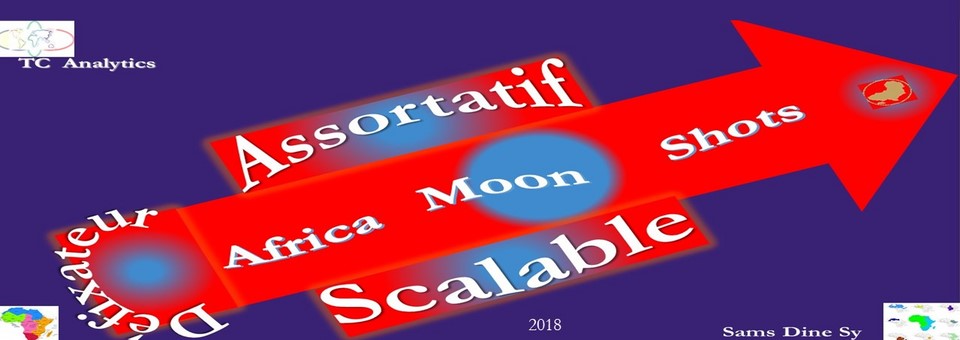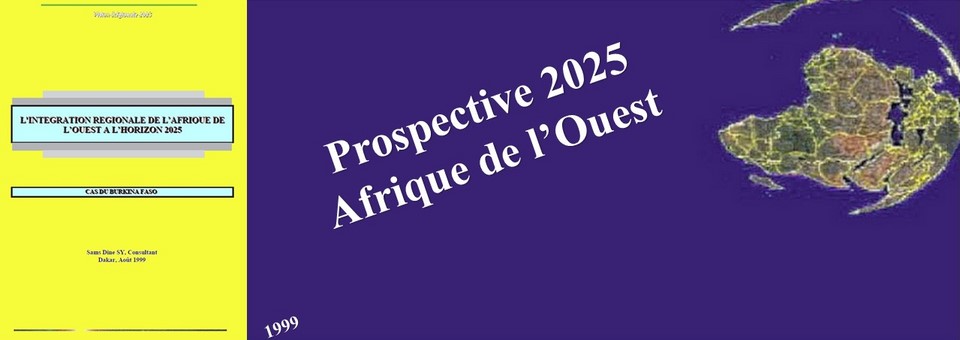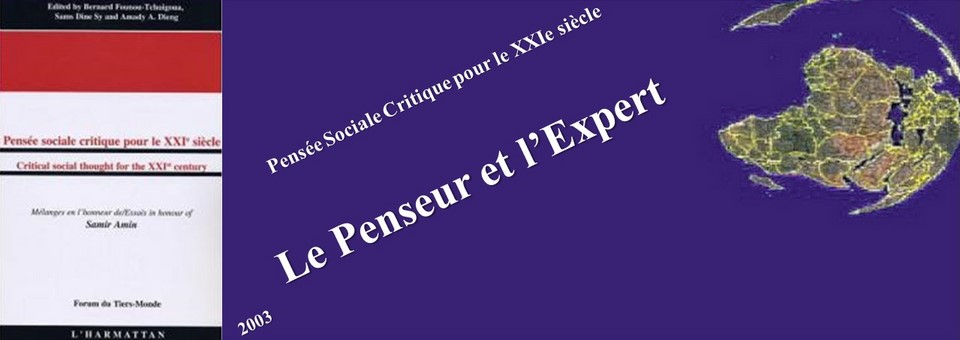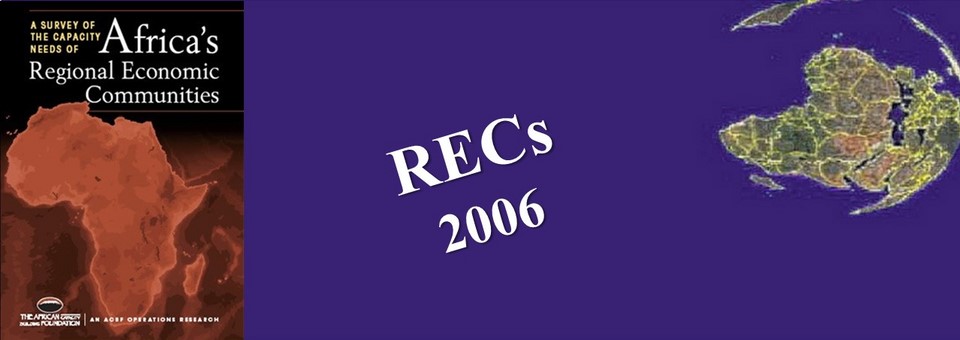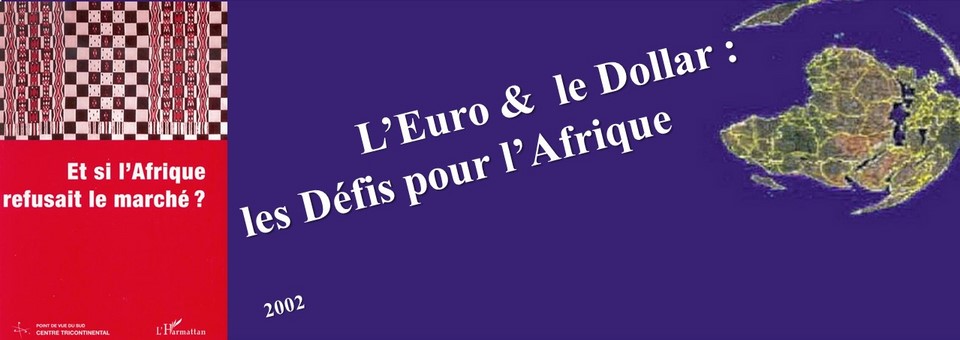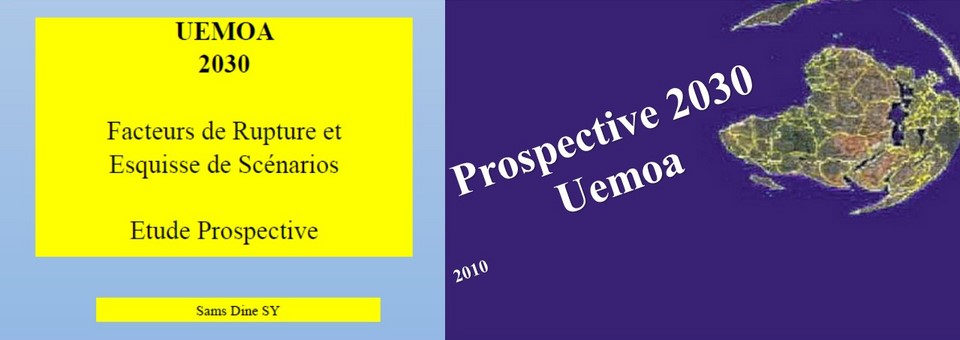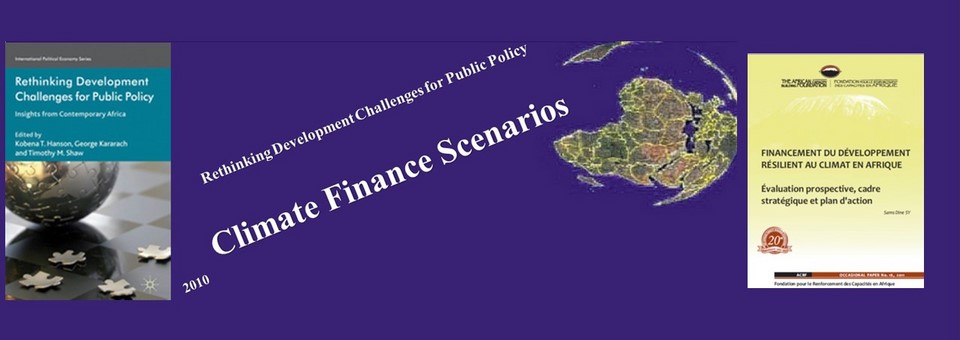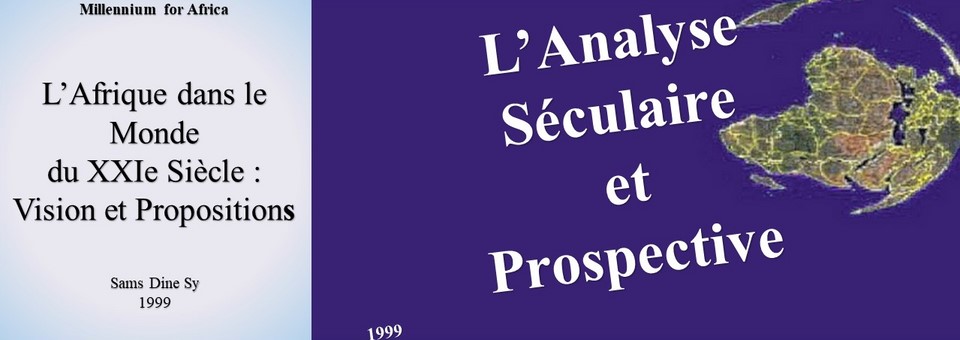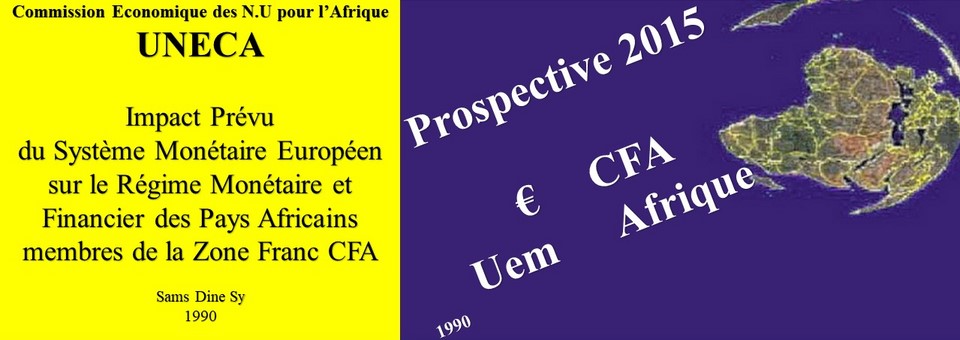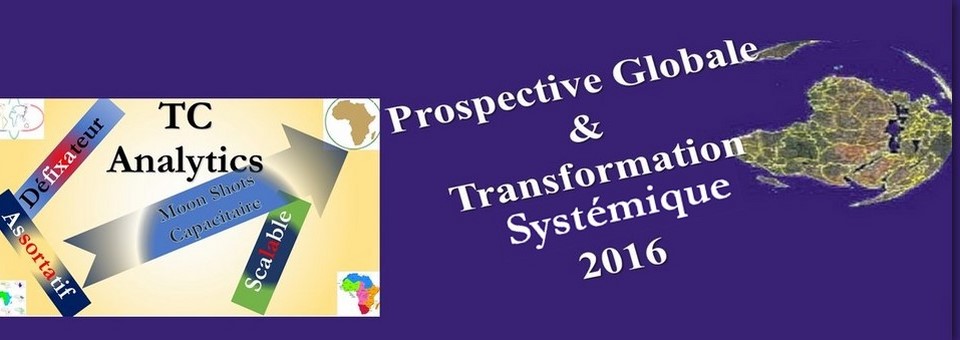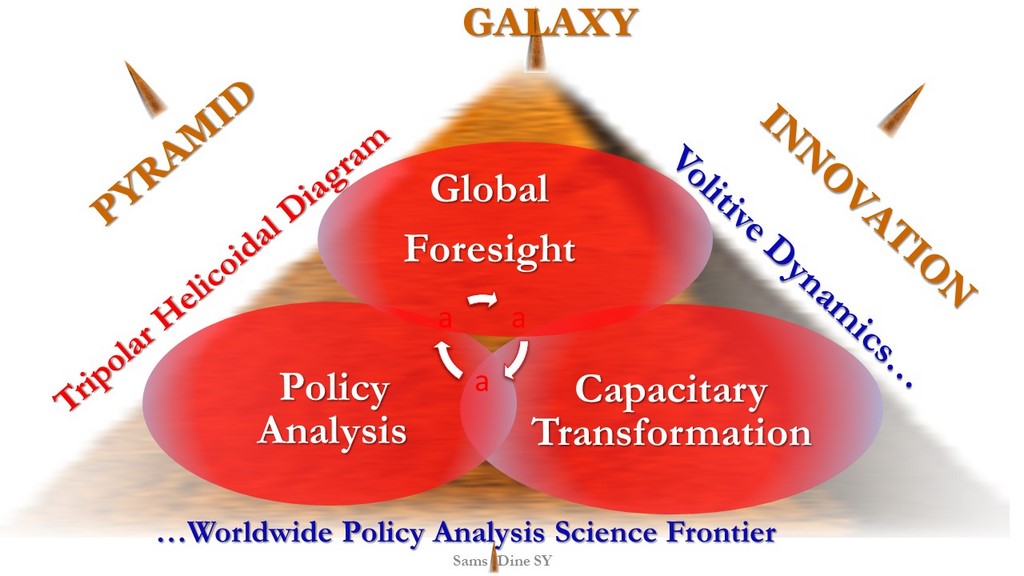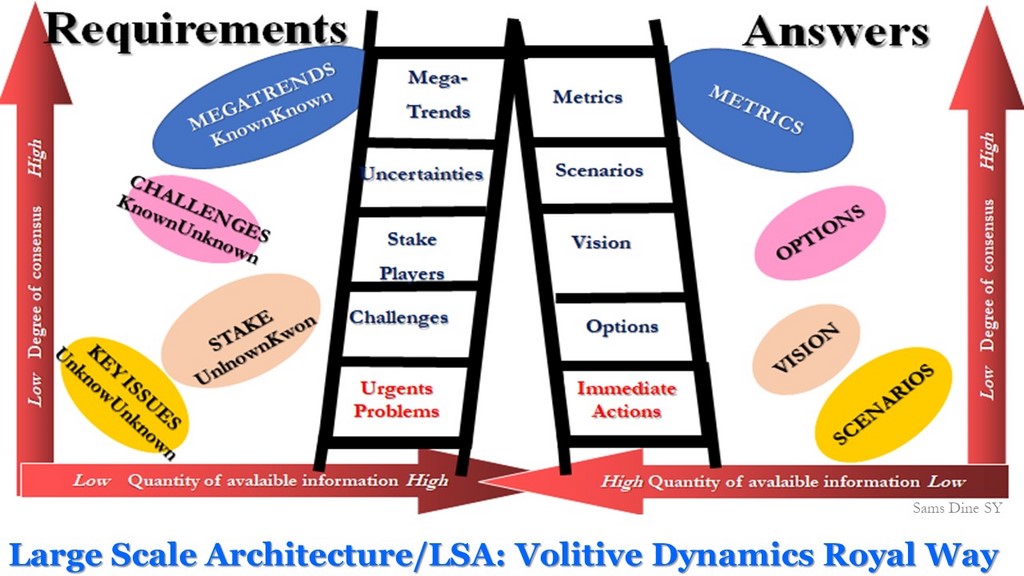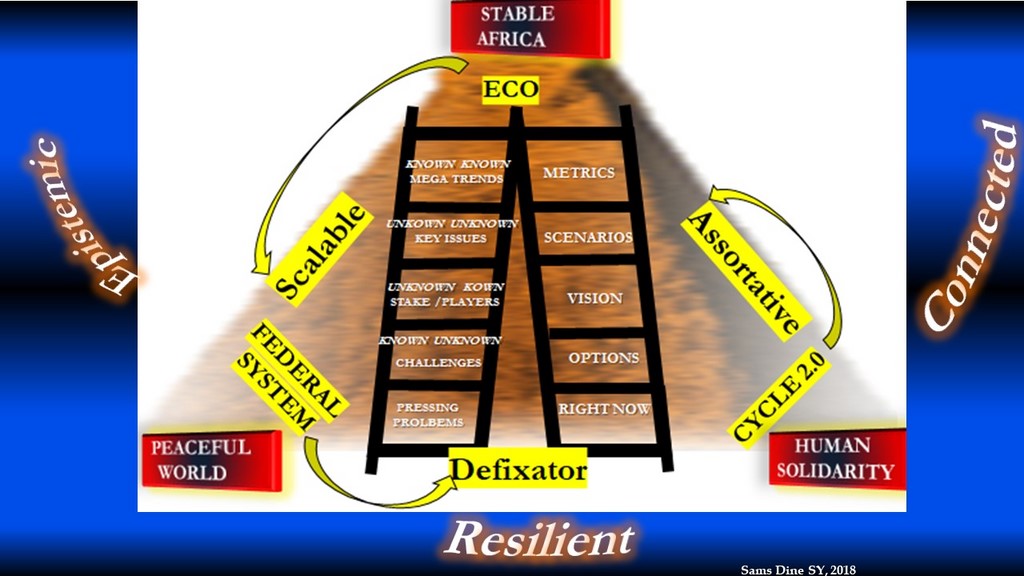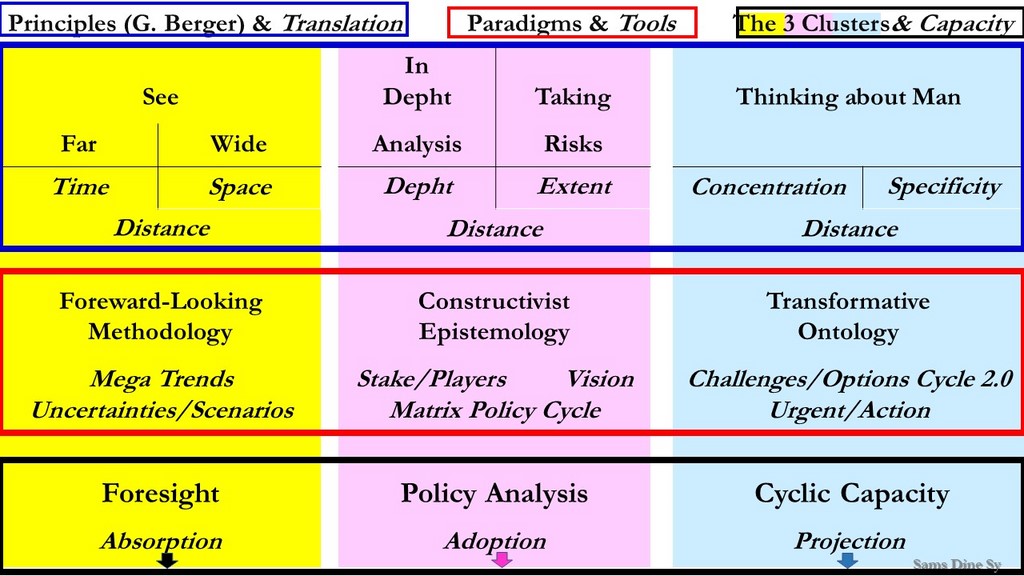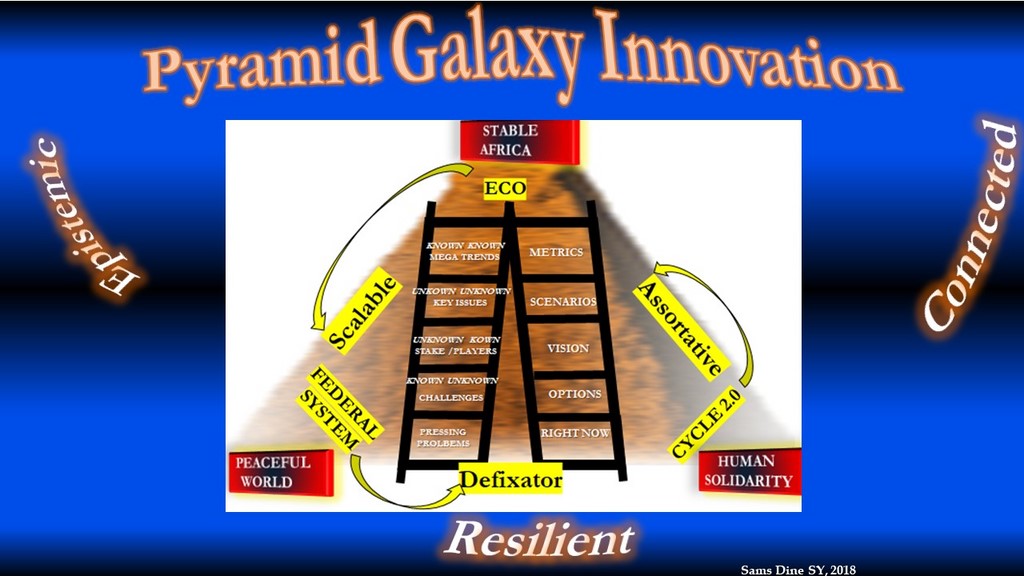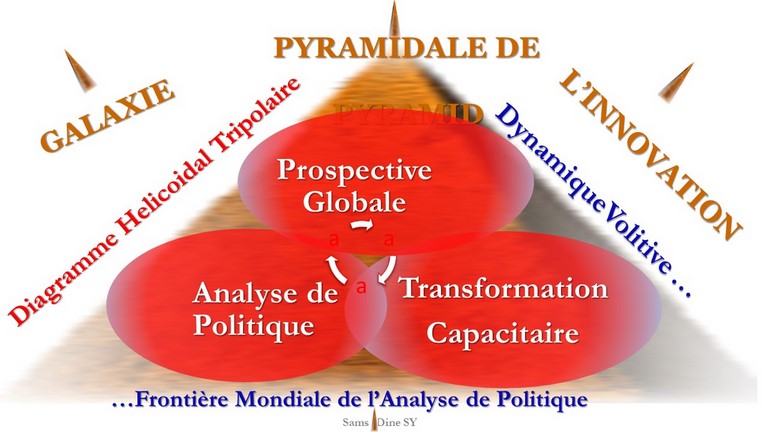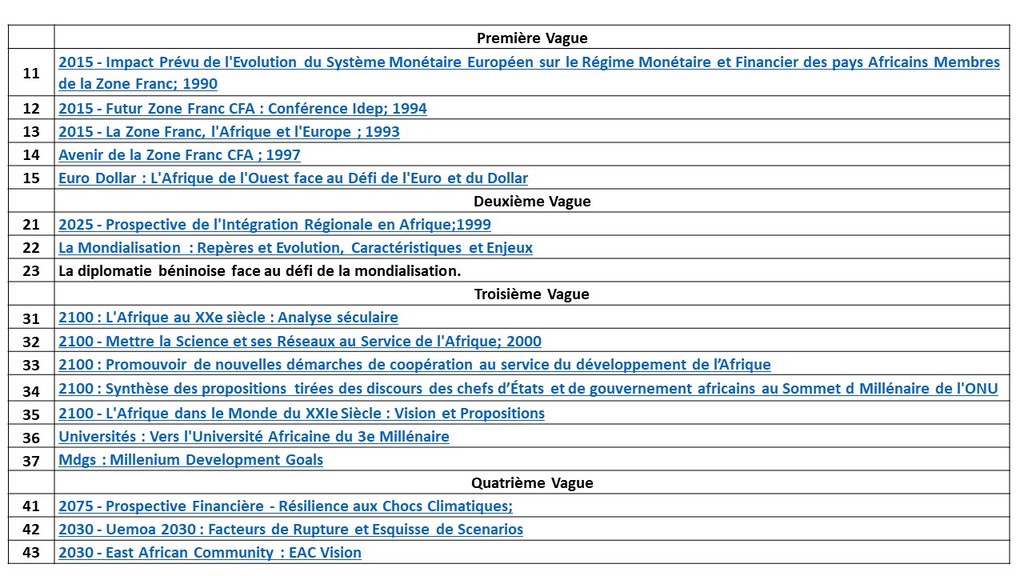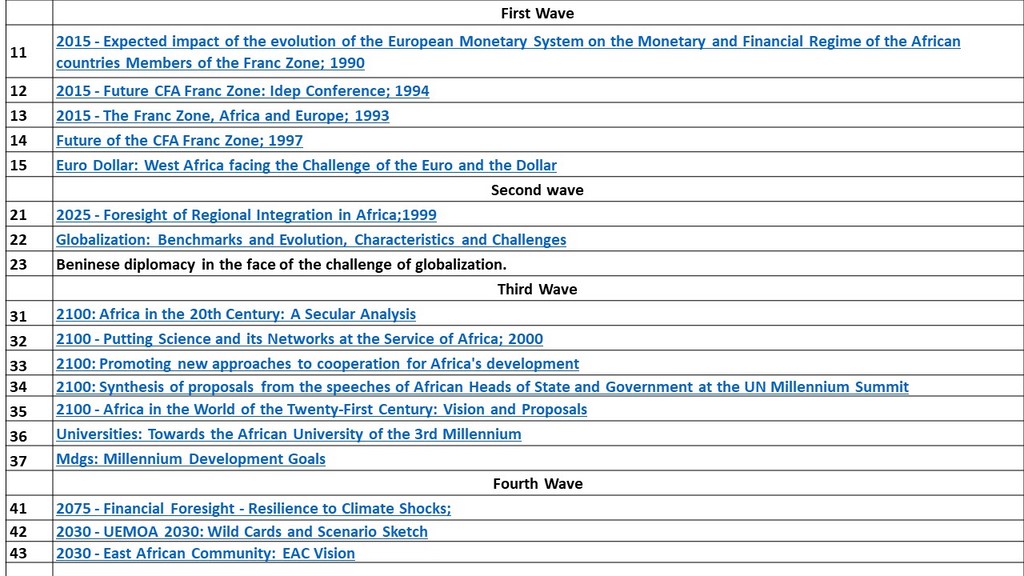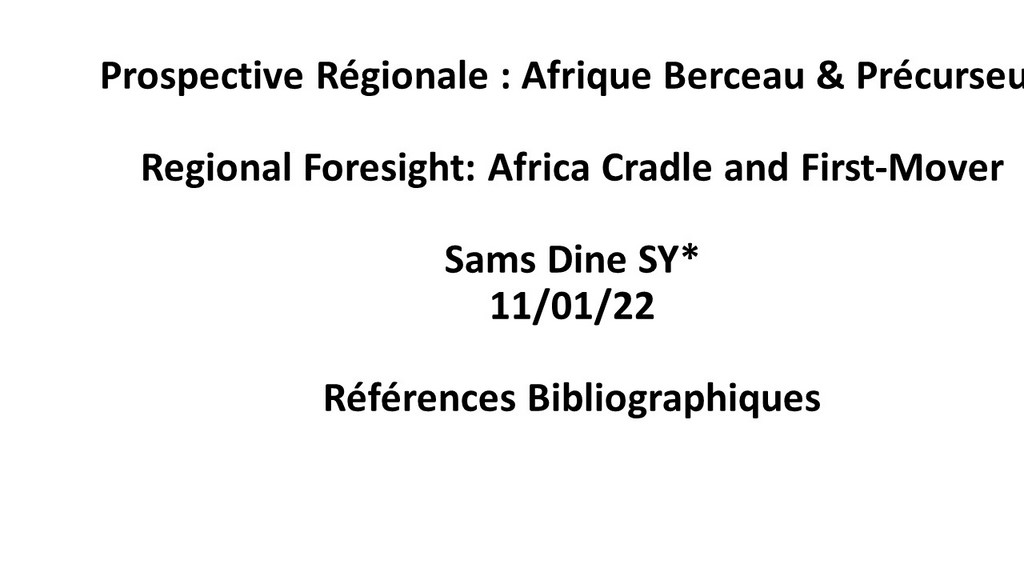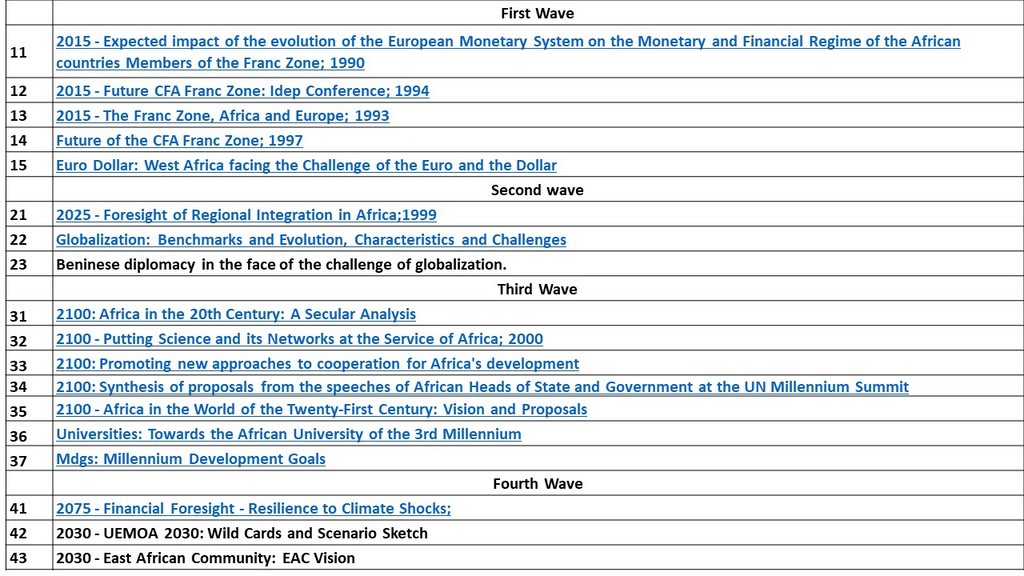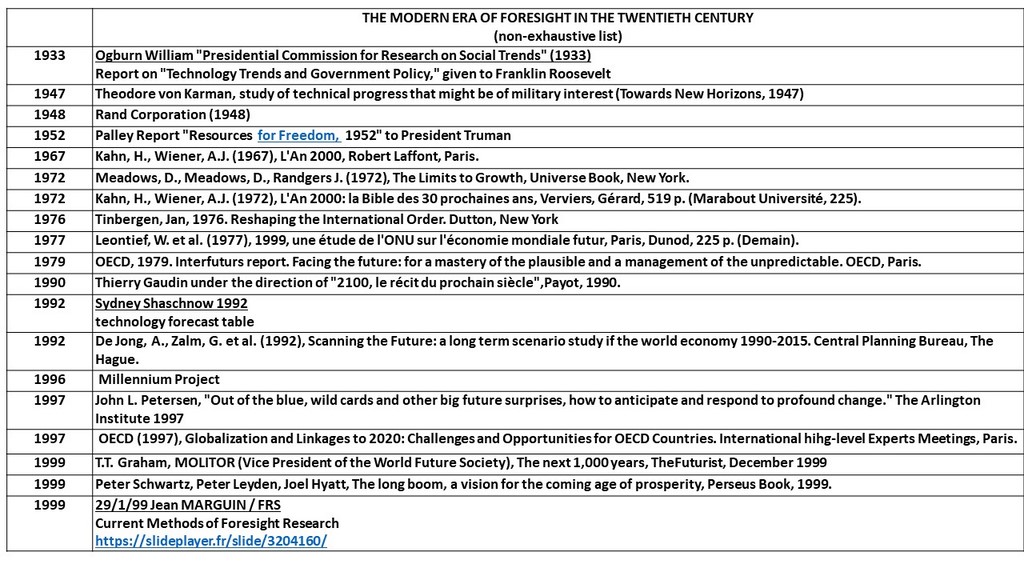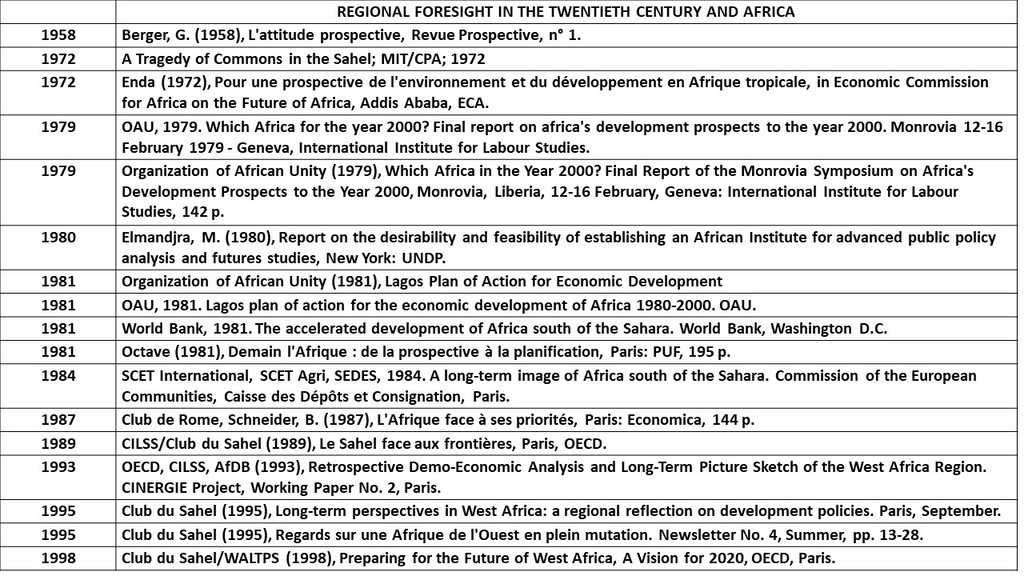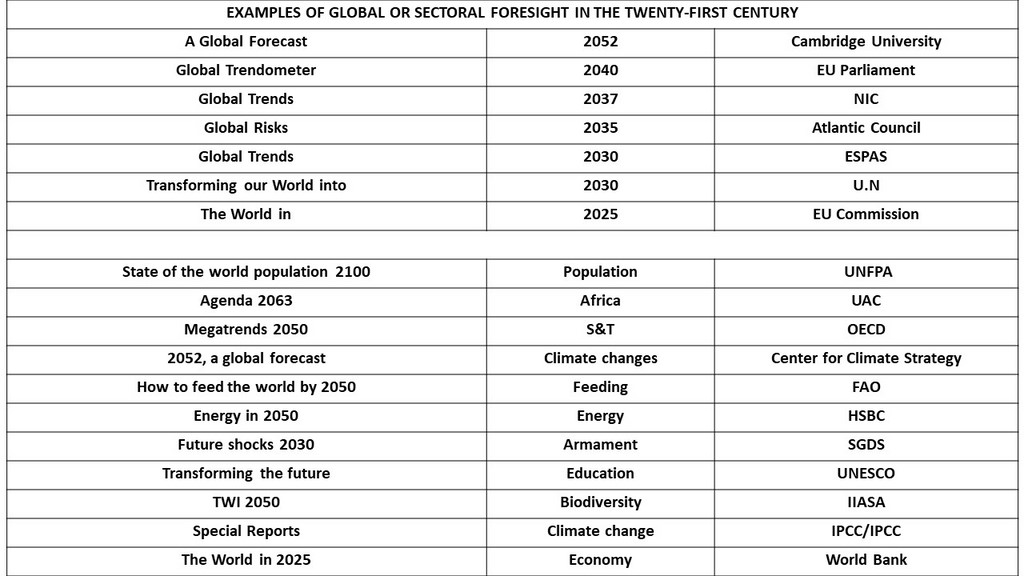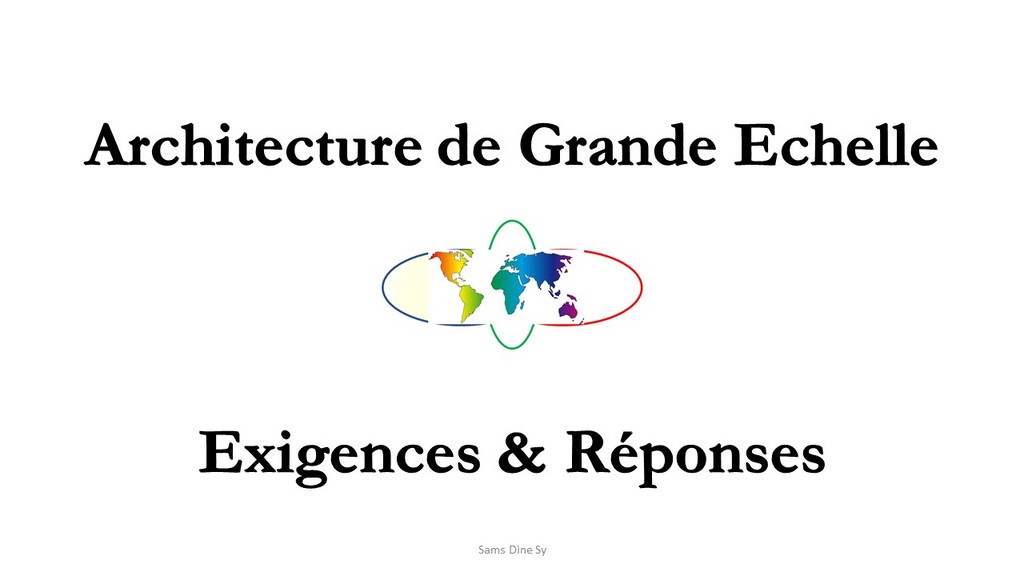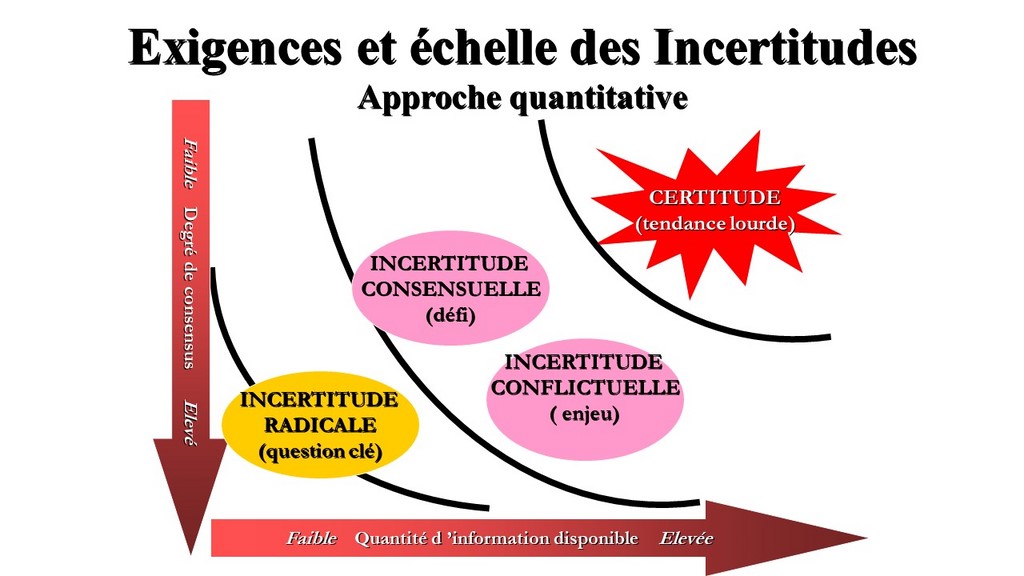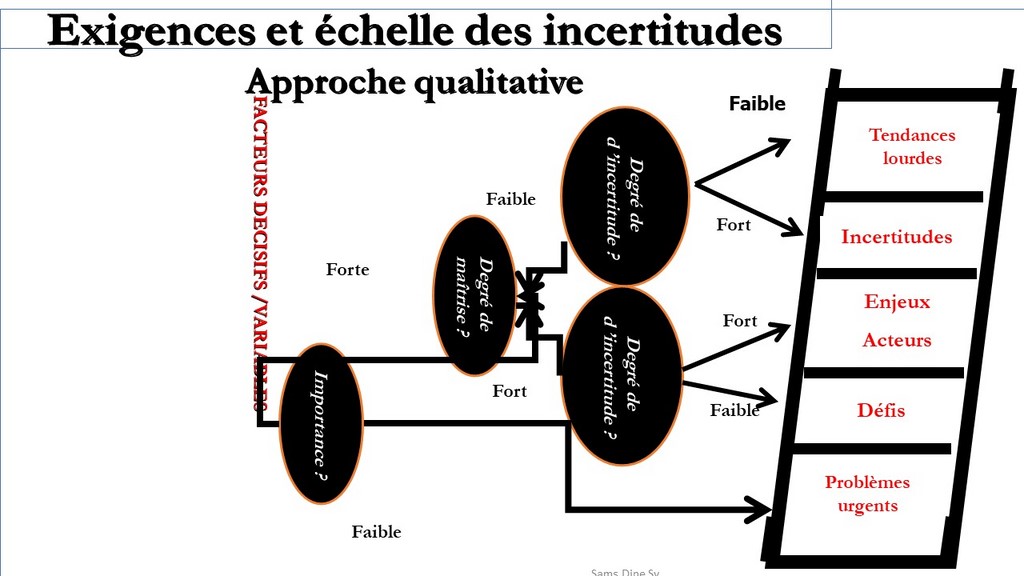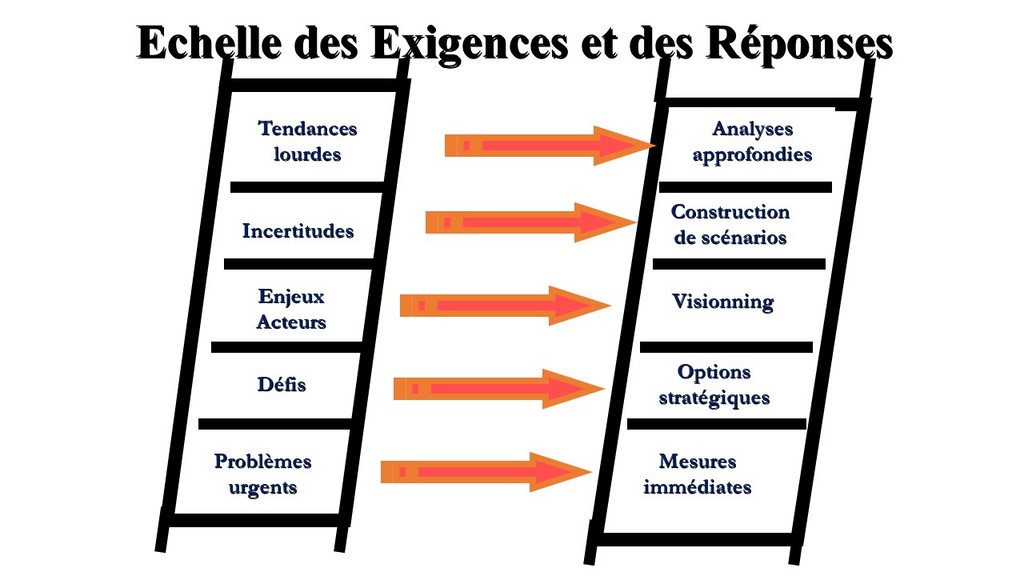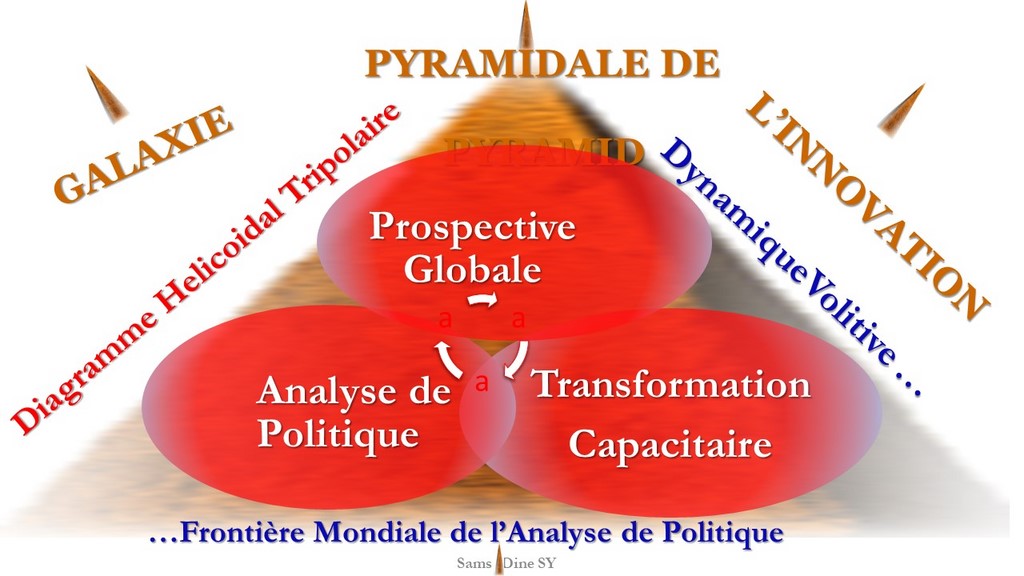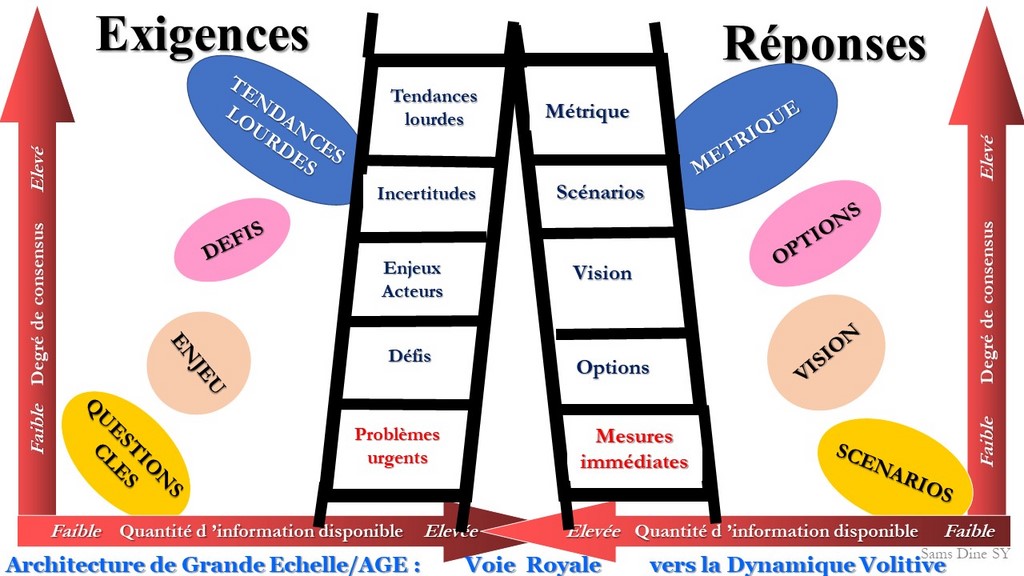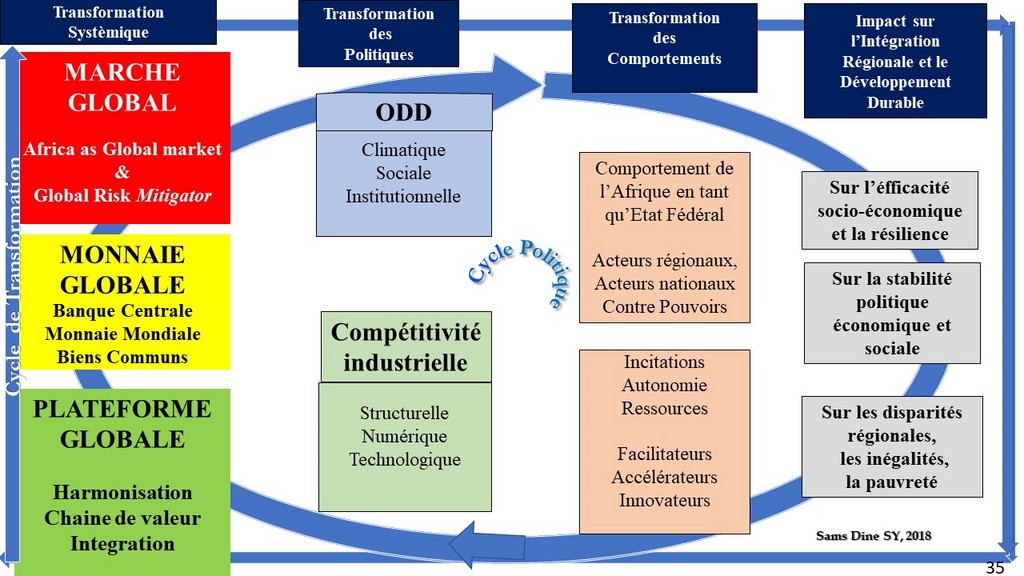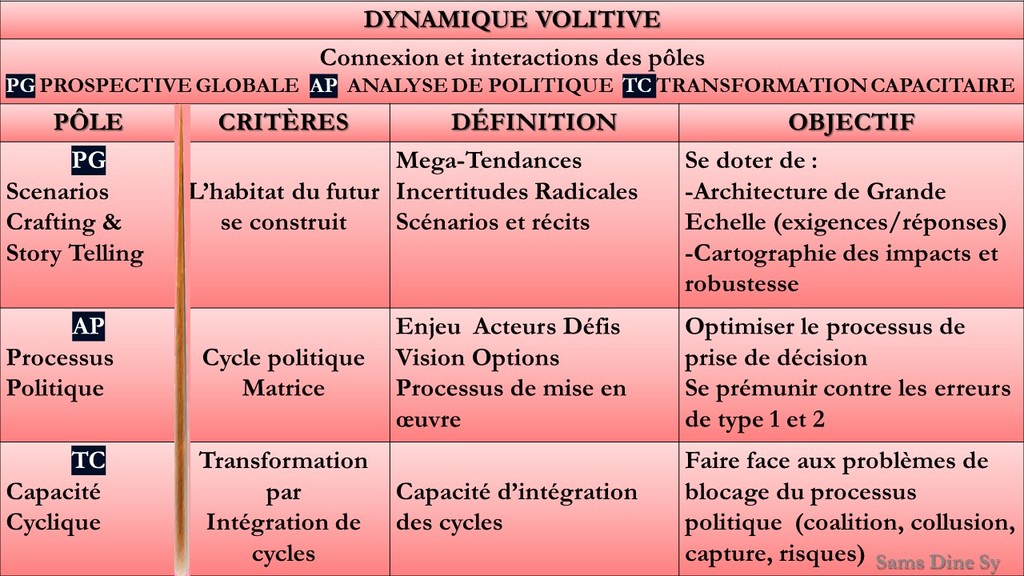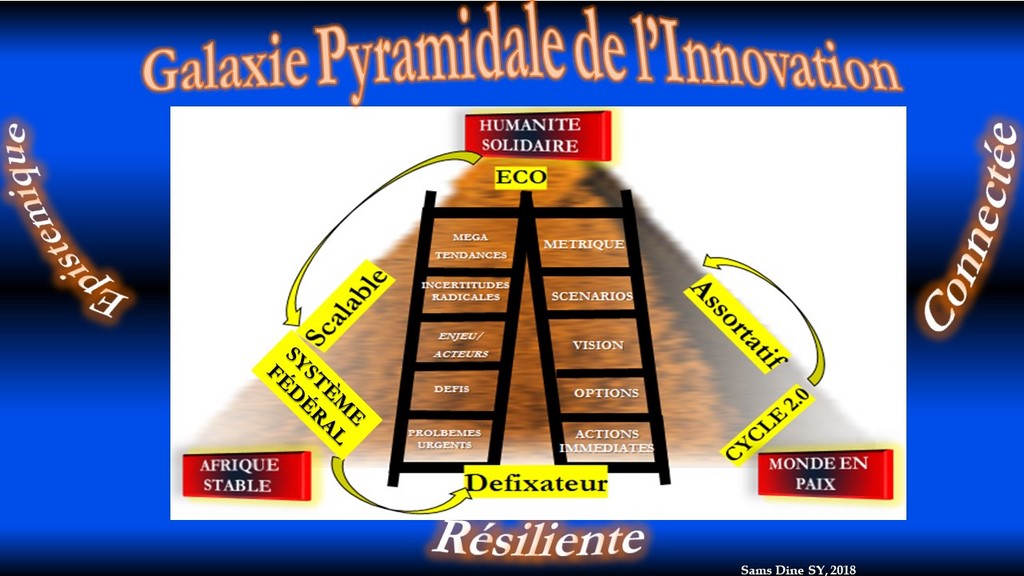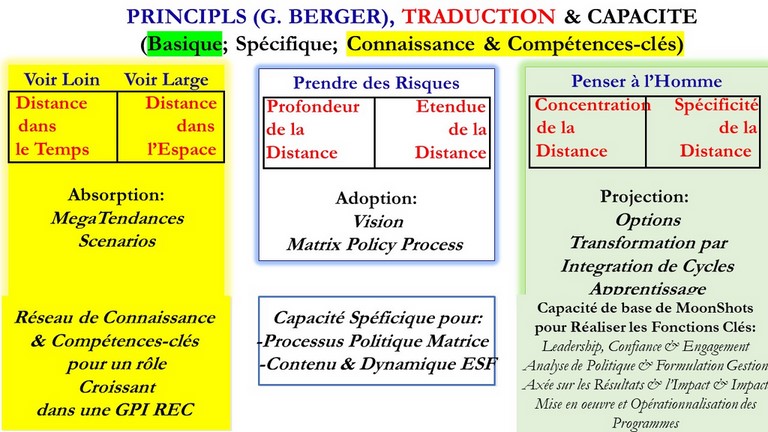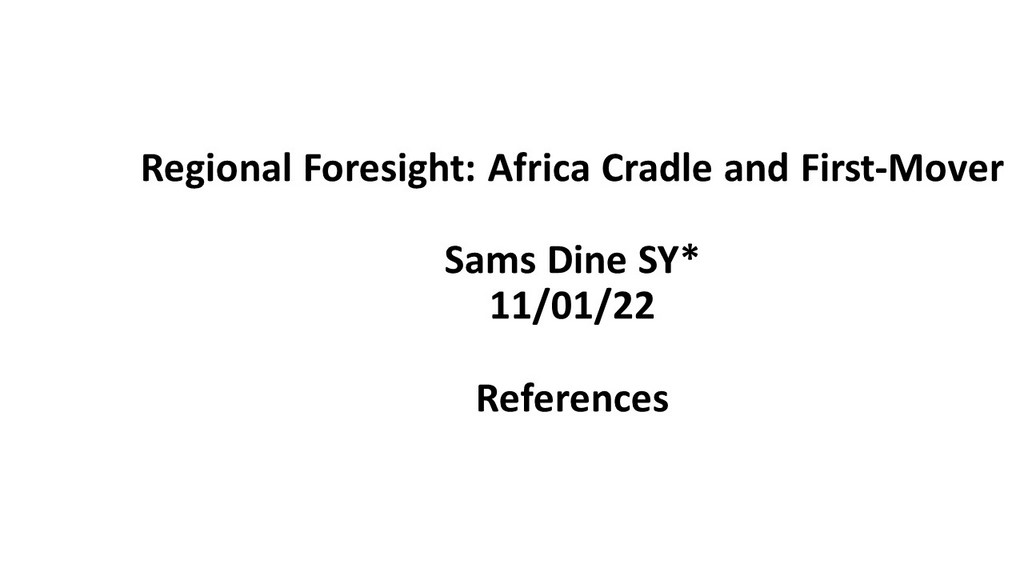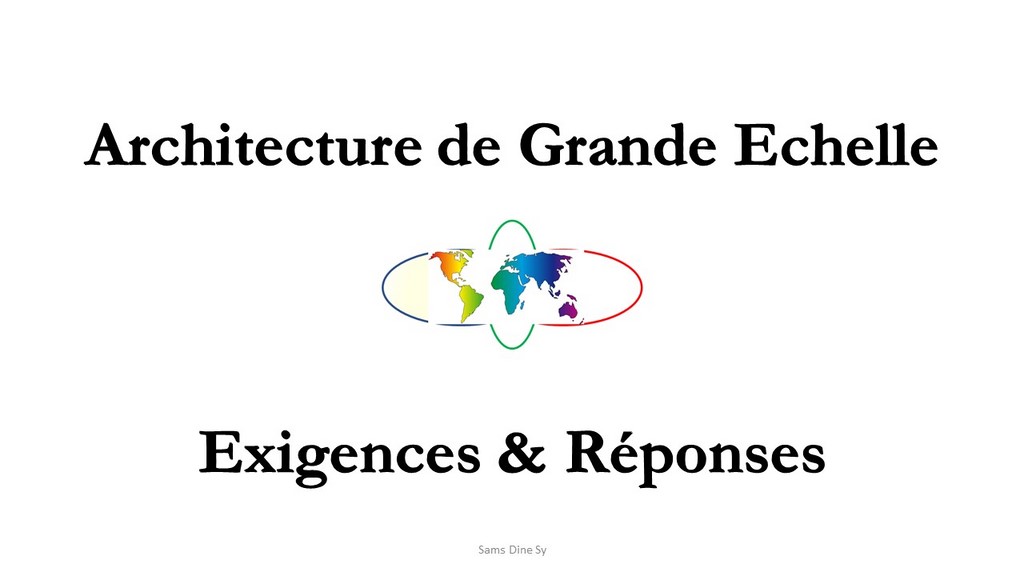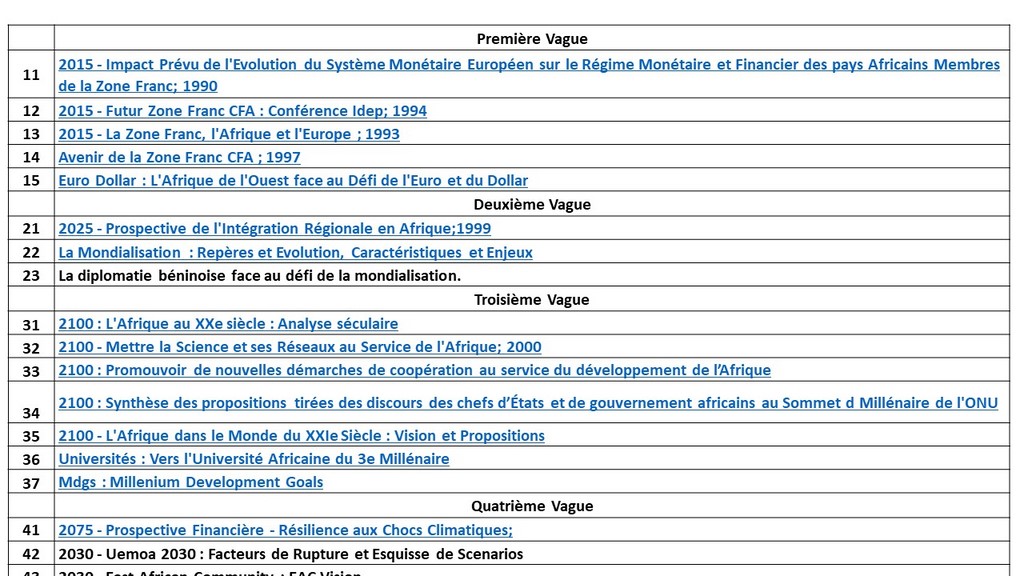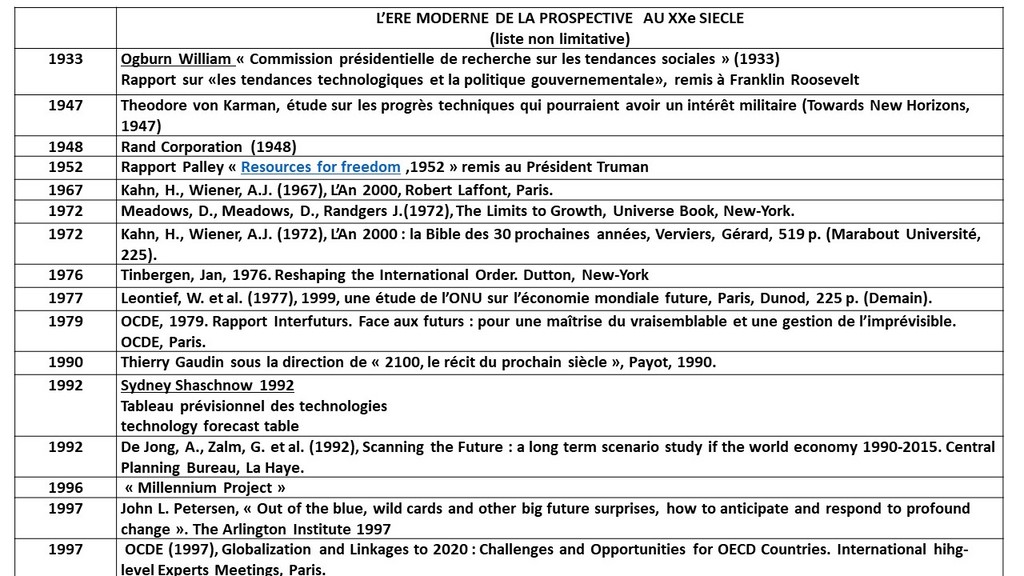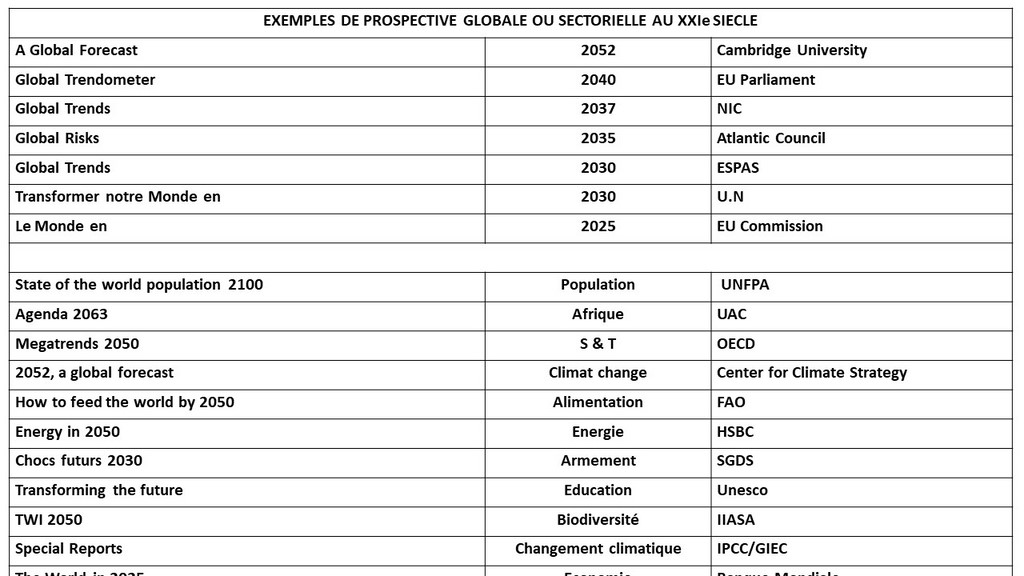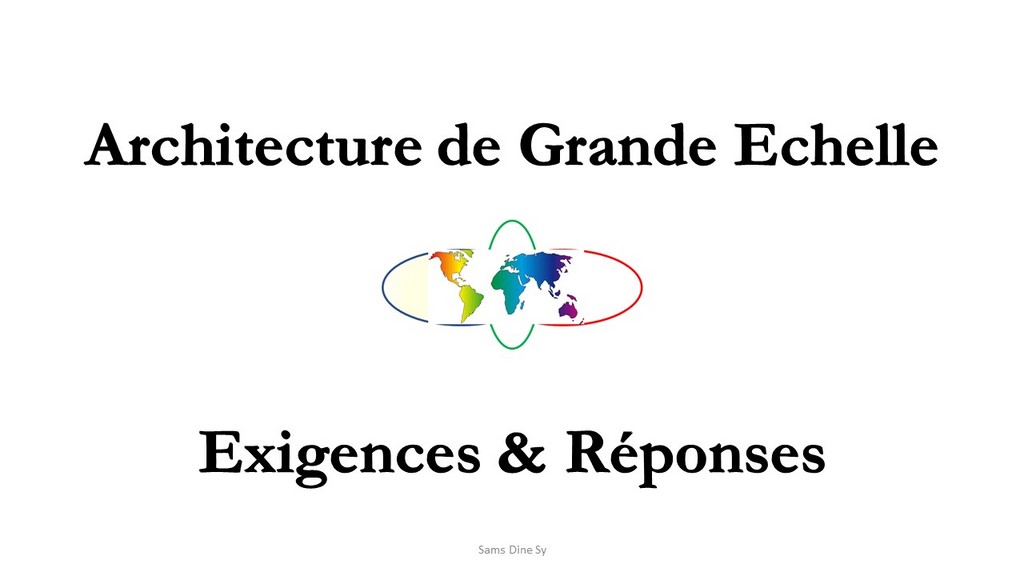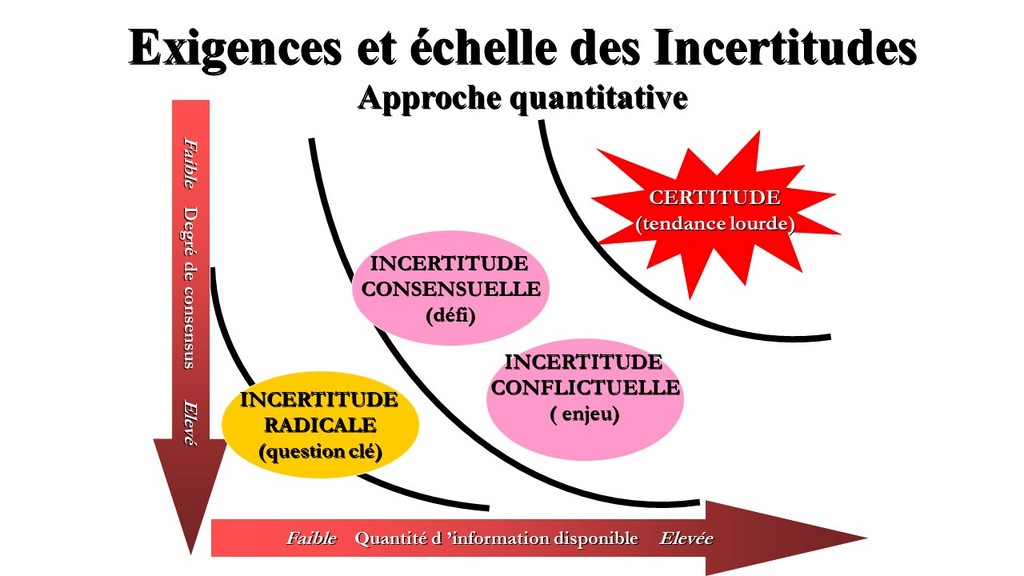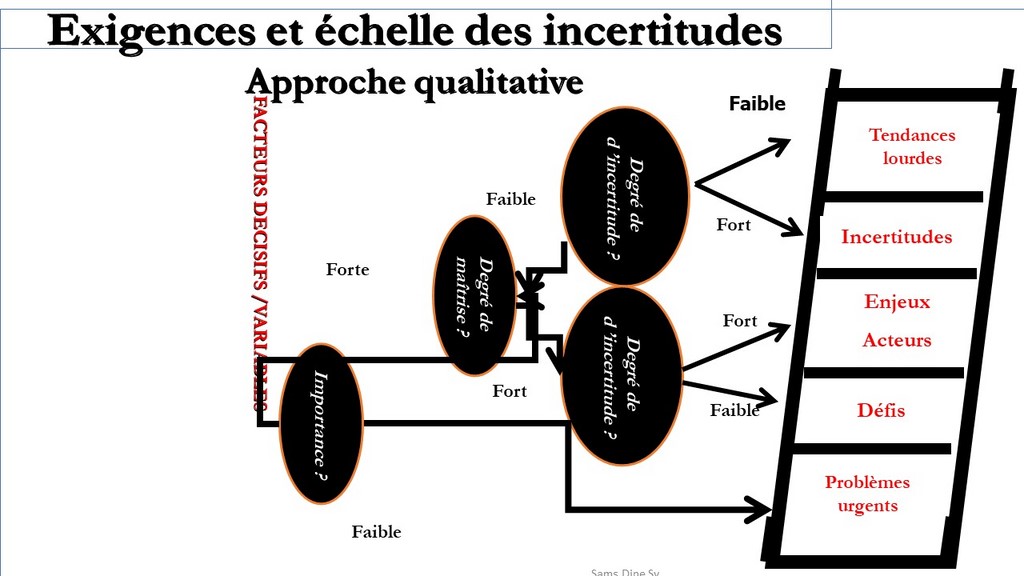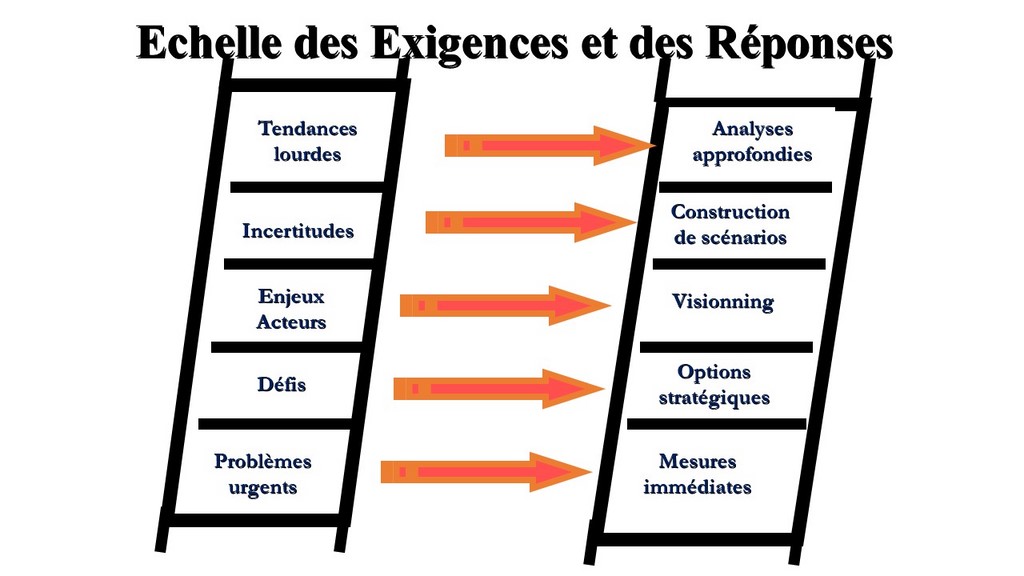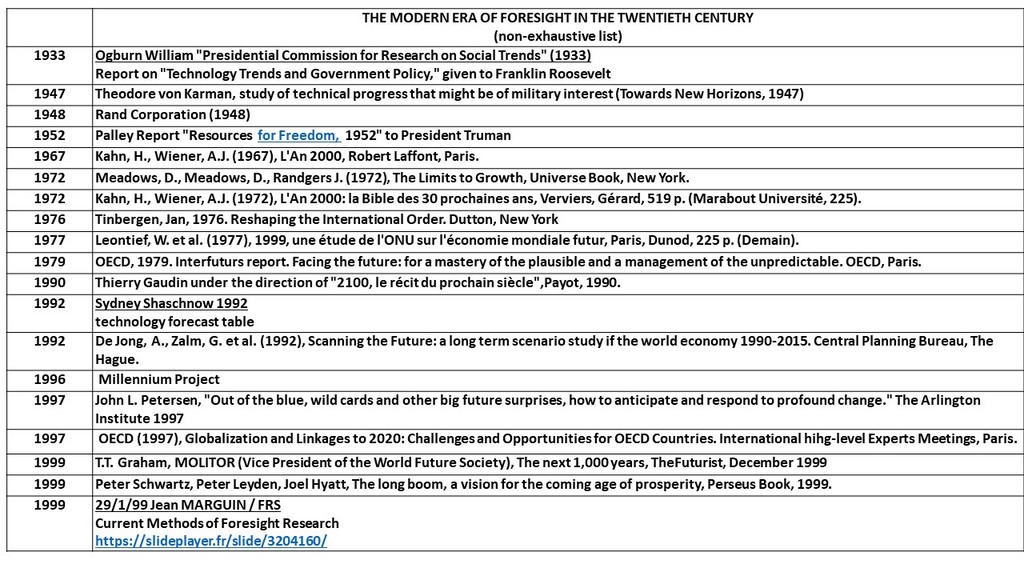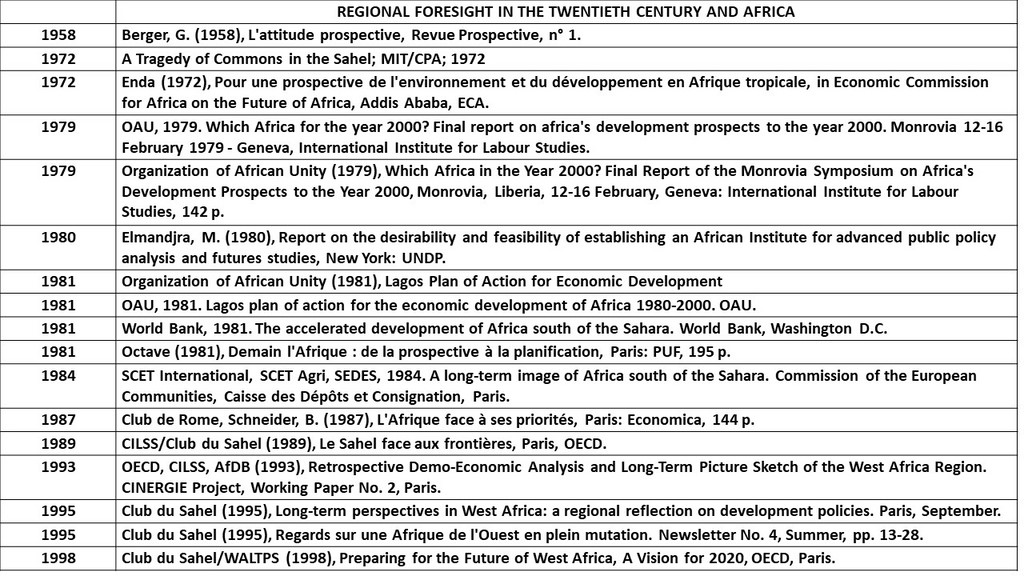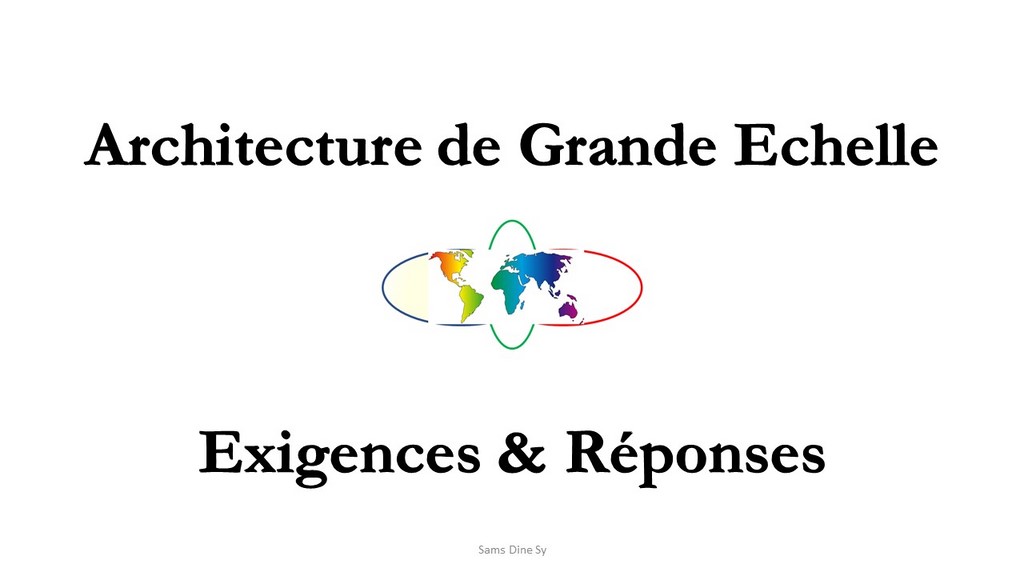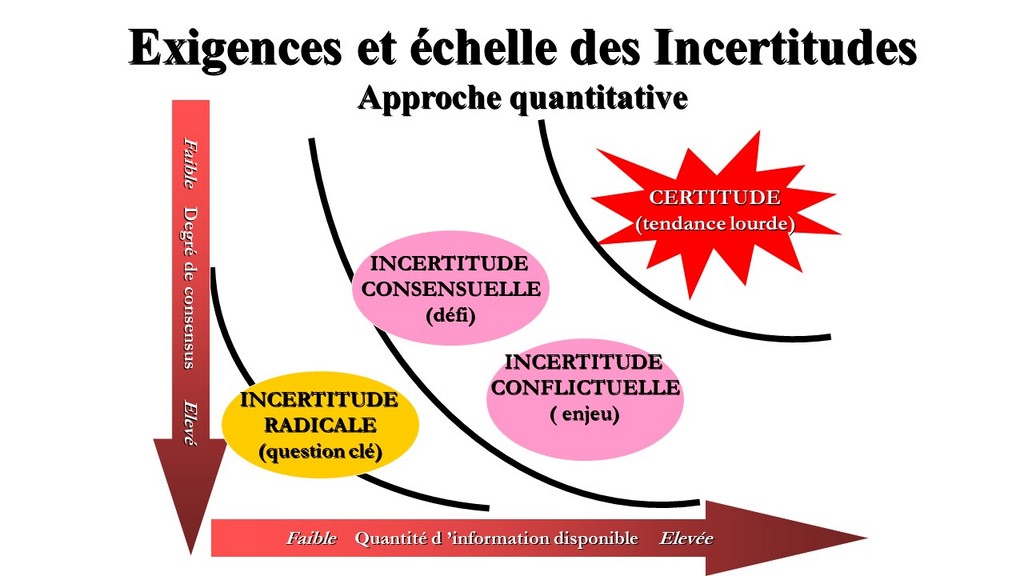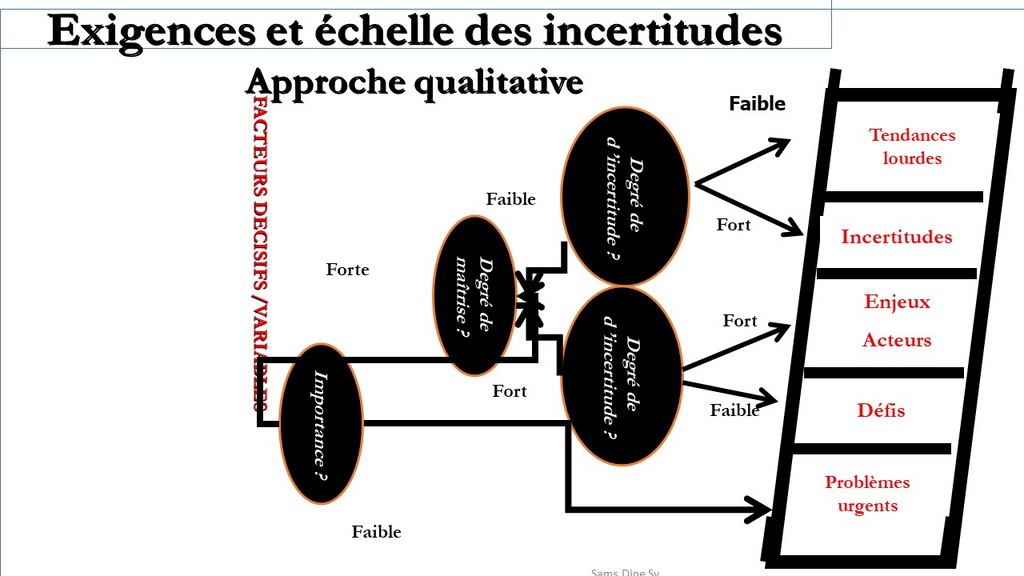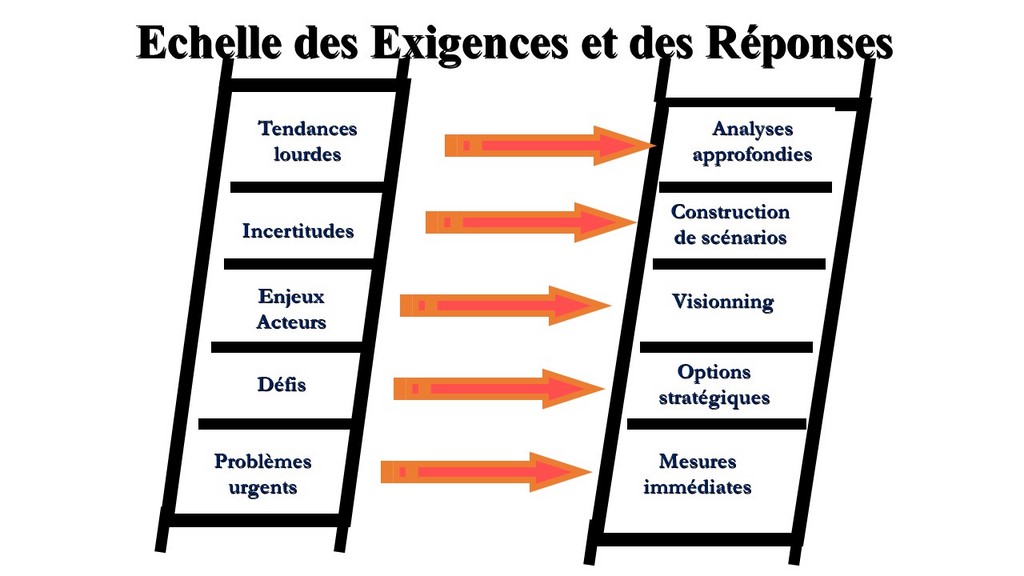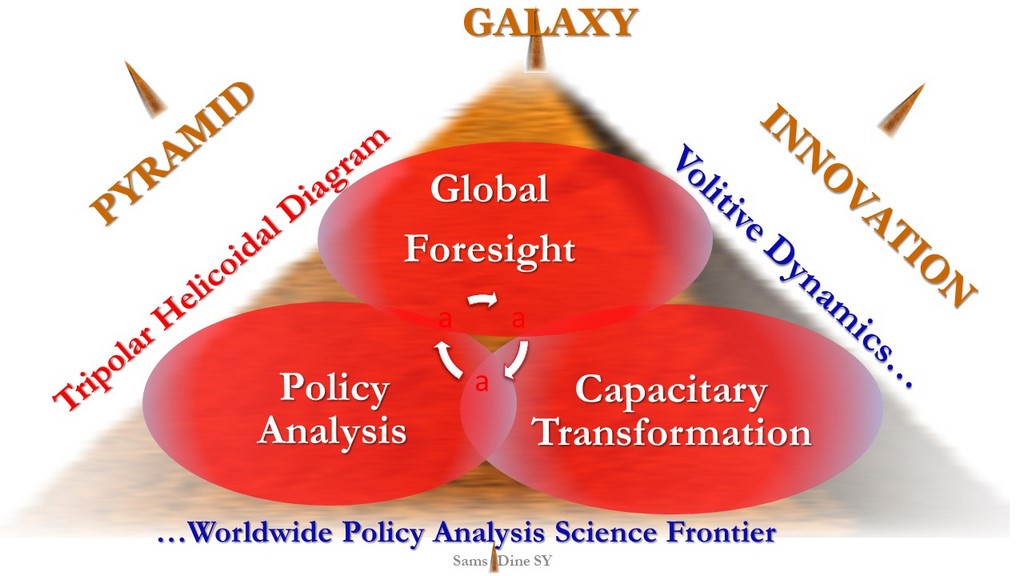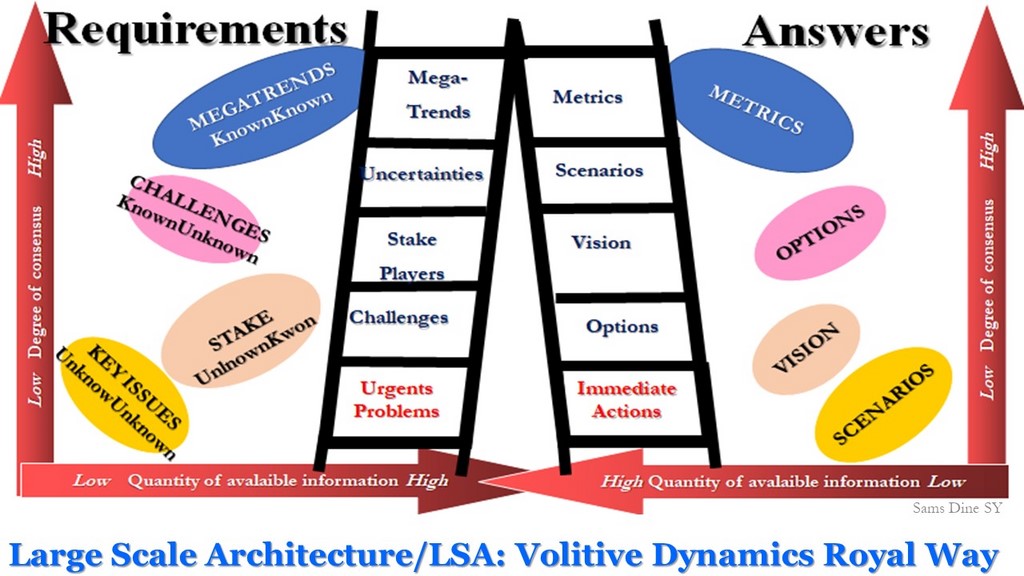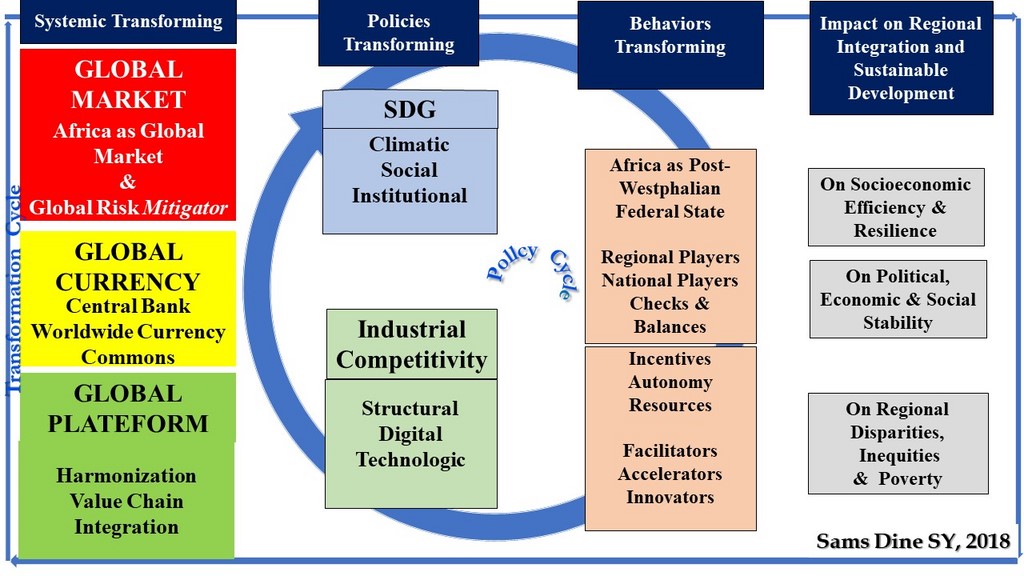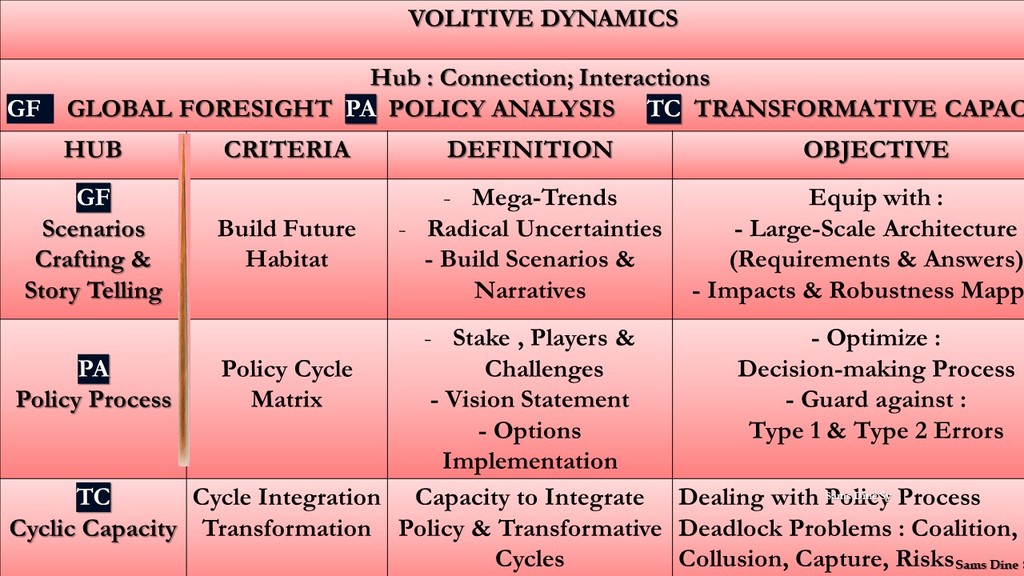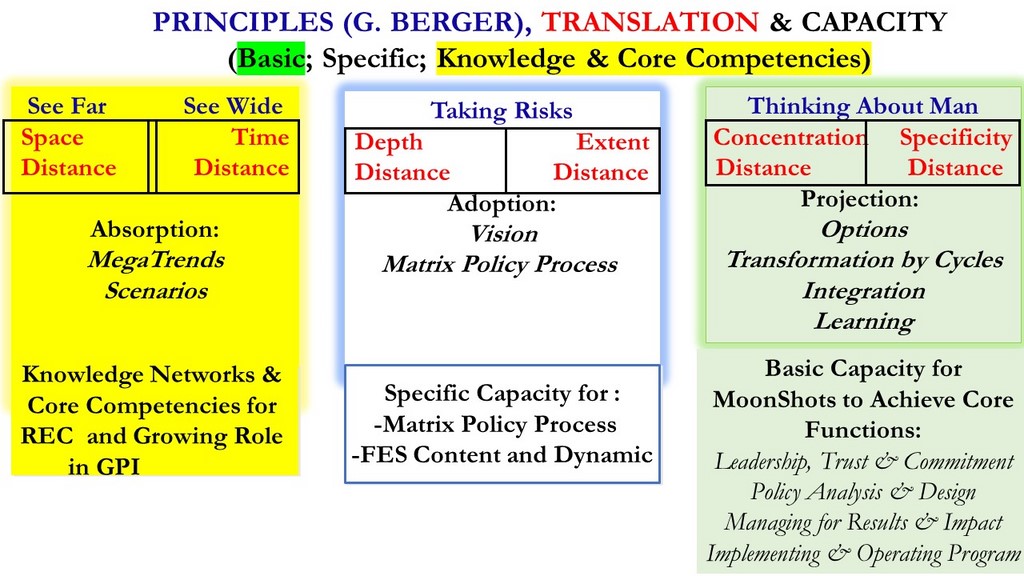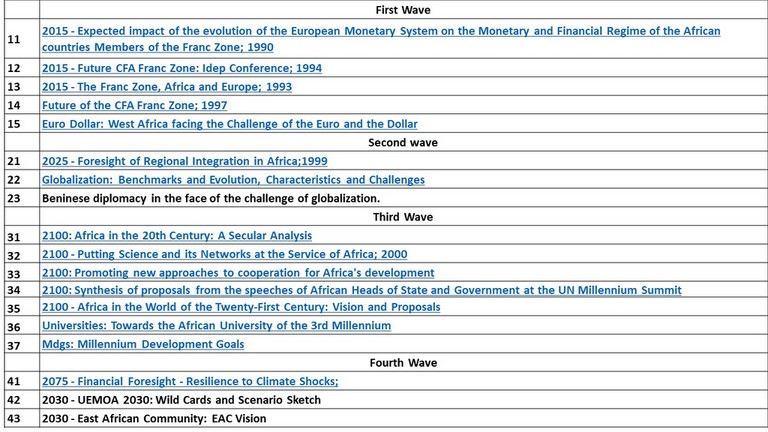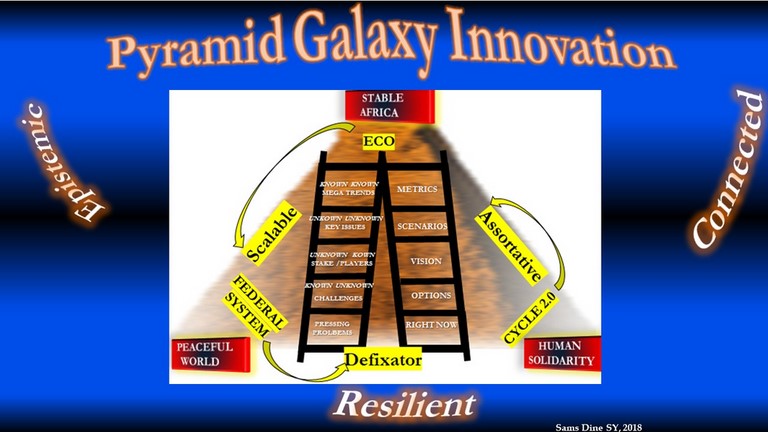Regional Foresight: Africa Cradle and First-Mover
Introductory Summary
But the main thing is elsewhere because in the meantime regional foresight has spread behind four waves from Africa. They break a taboo, transport the approach as close as possible to the countries, propel Africa into the twenty-first century and sound the death knell of the last vestiges of "Barbarian Europe". These waves, disparate in appearance, have in common the use of the Large-Scale Architecture, the royal way of foresight that they put back in its rightful place as a methodological paradigm of policy analysis. They cover a wide spectrum ranging from monetary integration to climate finance, regionalization, integration into the international system, the African university, science and its networks. They spread in the interstices of public policies despite all kinds of attempts to block, discredit and recover testifying to a low capacity of absorption of the supporters of the traditional approach called "modern era", made of alterations and forgetfulness that affect the region including Africa and research including the contribution of G. Berger. All these exercises are part of the humanist vision that this founding father of the discipline had and consecrate the return to the sources of the four principles that federate the notion of "prospective distance": distance in time (see far); distance in space (see wide); depth and extent of distance (taking risks); concentration and specificity of distance (thinking about man). They restore Africa's place as the cradle and first-mover of regional foresight and sound the death knell of the modern era after a century of drift.
Finally, the main challenge facing Africa during this decade is to put two points on the transcontinental agenda: to resolve all conflicts to make war impossible; dissolve the Security Council with a view to organizing the international system around the main regions of the world.
11/01/22
Summary
Section 1. Regional Foresight in Africa
1.1. What is regional foresight?
1.2. Why Africa?
Section 2. The modern era of foresight: between alterations and forgetfulness
2.1. Revisiting the modern era of foresight...
2.1. ... drifting towards synthetic telepathy and lyrical illusion
2.3. The 20s spell the end of the "modern era" of foresight
Section 3. Four waves of regional foresight spread from Africa
3.1. The first lifts a taboo
3.2. The second takes the approach as close as possible to the countries
3.3. The third propels Africa into the twenty-first century
3.4. The fourth wave sounds the death knell for "Barbarian Europe"
By way of conclusion
References
1. REGIONAL FORESIGHT IN AFRICA
1.1. What is Regional Foresight?
Regional foresight is the application of the prospective methodology to a region in the sense of an entity grouping several countries within the continental or intercontinental space. The methodology proceeds by exploration or prospective evaluation of certainties and uncertainties depending on the availability or absence of data and models. The approach consists in sorting between “kown” and what “unknown” to resume without reducing the typology of NASA / Arc (On space exploration andhuman error, 2006), resulting from the aphorism of D. Rumsfield and popularized by the taxonomy X-Events (Four Faces of Tomorrow, Oecd, 2011).
Sorting mobilizes four types of tools through the sequencing of major requirements and possible responses, to classify regional foresight exercises into two categories according to the mode and level of propagation of the results obtained. The distinction relates to the nature of the problem addressed (qualitative/quantitative, whether or not there is a model), the magnitude of the impact (availability of results at the level of countries, sectors or other regions) and the absorptive capacity (whether or not they can be replicated at other levels or integrated into public policy).
The first brings together the exercises on very long-term certainties and radical uncertainties.
The "Megatrends/Metrics" tool identifies demographic, environmental and socio-economic certainties(known known). Each megatrend contains an invariant (aging of the population, extreme or Anthropocene events, explosion of inequalities) while being exposed to Wild Cards (Schoks Mit, Black Swain) that emit weak signals whose ultra-traces must be constantly scrutinized even if the chances of detection are tiny.
The "Key issues/scenarios" tool identifies and classifies radical uncertainties (unknow unknown) according to their weight: globalization, geopolitics, regionalization, extent of disparities, resistance of populations, distribution of poverty... Each radical uncertainty calls for answers that are organized around a set of hypotheses whose combination builds scenarios and inspires narratives.
The first category includes most global, cross-sectional and epistemic studies as they are disseminated from one country, organization or community of countries to incorporate others. These exercises are characterized by slow spread of results and low impact because they require absorption capacities that are often lacking. Capacity building initiatives and programs that are supposed to promote the adoption of these exercises are still non-existent.
The second category extends the first and incorporates the medium/long term issue, the players involved and the challenges to be met in the short and medium term. The "stake/players" tool - multidimensional by definition given its link with sovereignty - identifies conflictual uncertainties (unknow unknown),of a military, monetary, fiscal, industrial, academic and cyber nature. The players compete around the stakes, mobilize a range of games / goals / targets to advance an agenda preferably structured around themes unifying a vision permanently exposed to disruptive factors and players games in presence.
The "challenges/options " tool lists consensual uncertainties known unknown) such as threats to a region and opportunities that arise. The threats stem mainly from scourges such as corruption orchestrated by private-agenda interest groups and mediocrity that causes the exodus of young talent. The opportunities come down to platformization and its promises of science and open innovation and integration around regional blocs. Each challenge involves assessing the capacities/vulnerabilities to threats (protecting/reducing) and opportunities (seizing/enhancing) to put on the table strategic options, define the policy process and cyclic capacity. These last two adventures are undoubtedly the most complex because they plunge foresight into the field of paradigms that structure policy analysis around a hard core and a protective belt. They require a good mastery of the scope and limits of the different approaches to the policy cycle and how to articulate with the transformation cycle.
The second category includes almost all national, territorial and sectoral studies, even when they show a regional claim or incorporate the results from the first category. They are characterized by the propagation of one-way results from actors who reduce foresight to a weapon of building their power by mastering the future and preserving the status quo. Capacity adoption (vision) and capacity projection (options) or nation building actions contribute to this when they simply replicate scenario- planning and promote the dissemination of arguments, discourses, narratives and cognitive biases to other countries or regions around metaphors and concepts such as TINA, Dialogue, Partnership, New Deal that invite their leaders to scan the sky in the hope of landing billions of dollars in their pockets.
1.2. Why Africa?
The importance of regional foresight makes it an indispensable bridge between the first and second categories of exercises. Nevertheless, the contrast is striking with the lack of interest in the approach since the entry of foresight into the so-called "modern era”, marked by its reduction to a toolbox whose exclusive use would be reserved for a few contributors and by the explosion of national and sectoral studies. If this approach centered on futurology (40s) and the systems dynamics (70s) serves as a reference for several hundred national and global studies from a small number of countries, it arouses more and more controversies under the effect of unanticipated crises and shocks and falls into the trap of the ancient tradition according to which everything is "written in advance" and that the mastery of the "future of the futures" is "possible".
Several waves of regional foresight exercises spread from Africa in the 90s, disparate in appearance but whose common point is the use of the “Large-Scale Architecture " .Because of their mere existence, these exercises fill the triple deficit of foresight that continues to ignore the region in favor of national and global studies, forgets research to the point of reducing the approach to a simple toolbox, alters the image of Africa reduced to a continent adrift and without a future. They thus neutralize the anchoring biases that persist in denying Africa any contribution to this so-called "modern era".
The themes addressed place the region in a multi-spatial and multi-temporal context. They cover a wide spectrum ranging from monetary integration to climate finance, regionalization, integration into the international system, the African university, science and its networks. These exercises are part of the humanist vision of foresight that G. Berger, the founding father, had of foresight. They enshrine the return to the sources of the four principles that federate the notion of "prospective distance": distance in time (see far); distance in space (see wide); depth and extent of distance (taking risks); concentration and specificity of distance (thinking about man). They restore Africa's place as the cradle and first-mover of regional foresight. This is not surprising for a continent that is unique in its kind in terms of its history, size, population, level of development, diversity, structure in zones, blocs and groupings of countries unparalleled on other continents.
The modern era of foresight has been drifting for three decades towards synthetic telepathy and lyrical illusion when it schedules in 2022 "African wars" and in 2024 a UN of 297 members. It's time to revisit it.
2. THE MODERN ERA OF FORESIGHT: BETWEEN ALTERATIONS AND FORGETFULNESS
2.1. Revisiting the modern era of foresight...
Foresight transports in time and space, a necessary condition to be present in scenarios but not sufficient to build the future, that is to say to find the prospective distance that allows to be an actor and especially to remain so in the face of the damage that the test of time and space inflict on the multiple exercises of foresight and which nevertheless give them a curiosity. This prospective distance touches reality at the same time as it contemplates it from afar. It therefore requires, on the one hand, the suppression of any finite temporal and spatial distance, interior, sensitive (country level, horizon, plane), on the other hand transport to the multi-spatial and multi-temporal distance (global level, long waves or cycle) infinite, external, suprasensitive. It transports the space-time of the imagination, allows to walk on earth while living in the stars, to move in a sphere instantly and continuously, to rise without losing the sense of reality.
Attempts to qualify foresight abound as it is deployed in the world: history in the future, present in the future, constructed future, science of the pro-active and systems, methodology of policy analysis and transformation approach, approach to anticipation, tool for specifying major requirements and possible answers. But the question of definition always arises as soon as we want to get out of the capture strategies by interest groups that have made it their business.
The first foresight exercises in the sense of futurology date back to the 40s within the Rand Corporation which developed the Delphi Method. They are conducted nationwide, first in the USA and elsewhere during the 60s. The deployment at the regional and global level is however slowed down by the oil shocks (72-78) and then the fall of the Berlin Wall, two ruptures that no study, forecasting model or system analysis had foreseen.
Three exercises are distinguished by their overall claim, which is all the more questionable as they are ordered by a country (USA, Netherlands), a group of countries (OECD) or a company (Shell). Their main contribution is methodological: the dynamics of systems for the "Limits of Growth (MIT/CPA, Club of Rome, 1972)", scenario planning (Anglo-Dutch Shell, 1971), preventive foresight (Interfutures, OECD, 1978) and Central Bureau of Planning (Netherlands, 1991).
It was not until the 90s with the Millennium Project (1994) that several institutions tried to reconnect with the approach within the UN. Outside Africa, regional foresight began to exist in Europe from 1999 (Europe 2010 Scenarios). Other "Global Trends" exercises started in 1997 at the World Bank (World Economic Prospects 2020) and the OECD (The World in 2020). This last exercise identifies for the first time Africa as an entity not dissolved in the Rest of the World or in the South, without conferring on it the status of actor; at most an issue or a prey.
2.2. . ... drifting towards synthetic telepathy and lyrical illusion
The "modern era" is above all punctuated by omissions and alterations that affect the region including Africa and research including the contribution of G. Berger. For example, the census carried out by Michael Keenan and Rafael Popper, covers 860 exercises in six regions of the world (North America, South America, Europe North, South, East and Asia), all relating to one country except one devoted to North America as a region (Comparing foresight "style" in six world regions;2008). Another study published by The Association of Professional Futurists (APF) (The Future of Futures Andrew Curry, editor, 2012) selects 57 publications to extract 16 laureates because of a contribution deemed decisive enough to break with 10 thousand years of clairvoyance (pythia), prophecy (oracle) and prediction (sybil) and switch to the "modern era" in the twentieth century. These two examples sufficiently illustrate the forgetfulness of the region and research.
G. Berger(1896-1960) is excluded from the second while he is the inventor of foresight, the first to distance it from prophecy and futurology, to distinguish it from forecasting, to elevate it to the rank of a discipline endowed with a school of thought, disciples and rules of conduct and to create a journal of the same name in 1959. No doubt he was too quarteron for the authors' taste. The latter only confirm the treatment of research in the country of adoption of G. Berger: his disciples are as numerous as the applications and attempts at recovery using metaphors (art of conjecture, futures possibles),chameleon concepts (future of futures), rustic processes (strategic foresight). It is only half a century after its disappearance that foresight is devoted to it as a school of thought, a circle of reflection and the title of a new journal. Obviously, all these omissions manifest the desire to make foresight a business, hence the choice made on B. de Jouvenel one of his disciples to be among the main contributors. P. Musso is to this day, one of the few voices to deviate from this drift when he invites to "stop starting from industrial and technological prospects that are often a by-product of marketing" (Territories and cyberspaces in 2030, Diact, 2008).
The contributions celebrated by the APF are more of a self-fulfilling prophecy in continuity with ancient tradition. Not content to forget the region, these approaches lock Africa into a rigid determinism, retaining from the continent only the demographic dimension, the available resources and the modalities of access. They are at most pythic or oracular foresight depending on whether the approach is qualitative or quantitative, both having in common the extrapolation of heavy trends. The first is illustrated as early as the 50s by the Palley Report submitted to President Truman " Resources for freedom, 1952" which makes African population growth a threat to the supply of resources to the planet. Using J. Forrester's Dynamo model "The Limits of Growth(MIT/CPA 1972)" confirm this hypothesis before the Club of Rome. Exploratory foresight of the "unknown-unknown" type thus gives way to preventive foresight (known-known) field of predilection of the dynamics of systems and their transformation by the multiplication of cycles based on network policy analysis and processes.
The oblivion of the region and research is all the more surprising since several regional foresight exercises had been initiated as early as the 70s. The oldest (A Tragedy of Commons in the Sahel, MIT/CPA, 1972) is conceived as an Electronic Oracle before inspiring a dozen derivative products published from Europe under various names to destroy any development prospect in Africa and guarantee free access to the continent's resources in the name of the Demo-Ressourcist tradition. During the same period, regional and even international bodies (Oau, Oecd, Cilss, Club du Sahel) launched work on Africa that is more aspirational or project of initiatives without a prospective basis.
The long-term image of Africa south of the Sahara (ILTA, 1984) rather negative was therefore gradually instilled from the 70s behind a series of Oau exercises by 2000 that are more self-fulfilling prophecy than "forecast studies". They serve as a belt for structural adjustment programmes to reach countries after darkening Africa's development prospects (Monrovia Colloquium, 1979), before delegitimizing the Lagos Action Plan (1980) with the Berg Report (1981) and the ILTA study (1984). The other national foresight work with regional or global pretension initiated since the year 2000 by the major powers does not come into play, being essentially designed in reaction or in response to the different waves of regional foresight that spread in Africa between 1990 and 2010.
In fact, it is almost all the national exercises with a global claim carried out in the twentieth century in the "six regions of the world" selected that take up the same antiphon on Africa: from "report on social trends (W. Ogburn, 1933) given to F. Roosevelt President of the Usa and considered rightly or wrongly as the forerunner of the modern era of foresight to that on "The World in 2020, Oecd, 1997" which for the first time, sketches a unilateral vision for Africa.
2.3. The 20s spell the end of the "modern era" of foresight
The Miltaro-Indutriel-Academic-Monetary Complex (MIAM), at the request of the American defense in 1996, goes even further (J. Marguin, 1999 P.14) by programming in the military sense of the term:
- 2022: African wars;
- 2024: UN membership reaches 297 (against 197).
China should have unveiled 15 more in 2006, which is not yet the case despite the pressure on Xinjiang and Taiwan, while other regions of the world are safe from atomization as long as their resources are freely available. All that remains is Africa to double the number of countries from the most remunerative targets that are the Central (Great Lakes), North (Libya) and West (Sahel) areas. The tiny Complex Miam of allies/vigils/auxiliaries are expected to mobilize to achieve this program in 2022.
Sydney Shaschnow's Military or Synthetic Telepathy, conceived in 1992 according to various sources including A. Toffler (War and Counter-War, Fayard, 1994) and H. Coutau-Bégarie (Traité de stratégie, 1999, Economica), will sort out those who master the models of interpretative or even discursive analysis, in order to punish those who remain behind. The latter are already experiencing bitter experiences, among other things, with the Aukus affair and the withdrawal from Afghanistan. The recent race within the new Triad (USA/G7, Russia, China) to whom can cause the most debris in space revives the challenge of atomization. Only Russia is taking up this challenge for the time being, as if to assert its ability to create as many as necessary to regain its greatness. China's reaction is long overdue: join the dyarchies mixed within the Triad (all Huns!) or program the obsolescence of this non-international system by announcing its withdrawal from the Security Council and the advent of the Organization of the United Regions (long live the Ur!).
The scheduling of African wars and other conflicts should not be taken lightly as it was part of the process of dispossession of former colonies in exchange for Marshall aid for free access to resources as suggested by all subsequent reports, from Palley (1952) to Mit/Cpe (1972). Since it is conceived as a megatrend, the application of the Large Scale Architecture makes it possible to carry out a robustness and impact test by starting of trapping the ultra-traces of the programmed atomization, scrutinizing the weak signals in the form of debris, locating the wild cards of the current boundaries and identifying the invariant.
Let's start by de-centering the gaze by applying this approach to the "digital cacophony from 2015 , P.13) another programming of the American defense - to trap these ultra-traces. The Gafam compete fiercely to be the best embodiment of the figure of the policy entrepreneur in its most repulsive form, combining "strong man", "teleology" and "transhumanism". The last step is this crazy race towards "metaverse" to the point of forgetting that they all stem from models of "Met@ organizations"(D. Ettighoffer & P. Van Benden, Global Village, 2000). This avatar derails NASA's SCaN initiative and scatters all sorts of debris turning the digital cacophony into "Wastewater that thinks it's Zem-Zem."
The resemblance to the demoressourcist grip exerted to atomize Africa is disturbing. In the wake of the American defense program, the Oecd sets out its vision for Africa (The World in 2020, 1997) which replaces that of the United Nations set out in the Millennium Declaration (2000) through the concept of partnership between rich (Americans, Europeans...) and poor (Africans) in order to assign them definitively in this status. African leaders spontaneously adhere to it, interpret it as a pledge of new deal through the "New African Initiative" before being dictated the terms of the New Partnership for Africa's Development (Nepad) at the Genoa Summit. But a pluralistic prospective assessment in the form of the Action Plan for the Implementation of Nepad (2007) sends a weak signal to the G7 and tests its absorption capacity. Seeing it as a threat to its supremacy, the latter transposes to Africa the successive military interventions of the « Desert Sabre, Desert Storm » type in order to elevate the continent to the rank of "hybrid threats" behind the th "i"s (immigration, insecurity, identity). In the aftermath, supremacists, lone warriors and other nostalgics for the call of empire mobilize all those left behind by the niche war allowed by Synthetic Telepathy, dissuade the leaders of the countries of origin from welcoming them and direct them to Africa: special operations entrepreneurs from West Asia demobilized after the Soviet withdrawal from Afghanistan, guardians of the colonial legacy disguised as lords of aggression, cross-border, mercenaries of ethnic cleansing, terrorist commandos, networks of hostage-takers, traffickers of weapons of mass destruction, human beings and narcotics, cybercriminals, promoters of ethnolinguistic conflicts, food and medicine racketeers, financial criminals, confessional militias...
But all these invasive species cause debris that renders obsolete many geopolitical or economic concepts such as the distinction of type Heartland / Rimland, North / South, Oecd / G77, Usa / Row (Rest of the World), Indo-Pacific / Southern Mediterranean. Weak signals from different regions of the world no longer make it possible to locate debris in rich or poor countries but reveal their atomization under the effect, not of conflicts but of the insufficient absorption capacity of the regional foresight that spreads from Africa behind four waves pushing back all kinds of obstacles.
3. 1990-2010: SEVERAL WAVES OF REGIONAL FORESIGHT
From 1990 onwards, several waves ofregional exercises spread to Africa and to a lesser extent to Europe where the initiatives of the European Commission were nevertheless considered failures. The first, "Scenarios Europe 2010, 1999" is accused of lacking rigor, while "The World in 2025, 2009" is still unfinished. These two exercises bear the brunt of rivalries between experts, ego quarrels between bell towers and minarets, inevitable when foresight is reduced to a toolbox subject to restrictive conditions of use behind a single system model at the risk of locking the policy process into a single cycle divided into sequences to be renewed to reinforce the adage that Europe advances only after each crisis. This is how she locks herself into the lyrical illusion.
The spread of regional foresight in Africa is organized in 4 waves not remotely controlled from a country and all at the initiative of the United Nations (Eca, General Secretariat, Undp and Acbf). They first break the taboo that surrounds the base of the Miam complex, the last vestige of Barbarian Europe, this Syndrome of Lyric Illusion Darwinian Acquired (Silda) address the key issues of globalization and regional integration, propel Africa into the twenty-first century to different horizons, remove traps and other attacks by denial of sovereignty.
Propagation respects the classic modalities of any disruptive innovation. The incorporation of the methodology into initiatives, plans, programmes and projects, followed by the prospective evaluation of the various benefits triggers the exit from the long period of austerity through the development of capacities in key sectors (project execution, start-up), drives the transformation of Africa by the twenty-first century from countries (9th Podes) and Building Blocks (CERs, Waemu, Cemac). The approach promotes the creation of a critical mass of professionals, experts and researchers in fields as varied as policy analysis (Idep), market management and finance (Cesag), economics (Universities), higher education, regional central banking, national public administrations, regional economic communities...
Unincorporated, it generally results in the specification of major uncertainties and the construction of scenarios, the identification of disruptive factors thus leaving it to stakeholders to test their absorption capacity (Fcfa Zone, climate financial forecasting, globalization), to state the vision and the resulting options (Waemu 2030, Eac 2030).
3.1. The first wave lifts a taboo
It is spreading within the CFA franc zone, exposed to a potential shock exerted by the European economic and monetary union programme in the making. The decision to address the problem of the future of this area comes up against attempts to block, discredit and recover which end up revealing the real stake since the publisher of the Marshall Plan exercises an exclusive property right reducing the former colonial powers to the role of vigil despite the incessant calls for the restitution of their heritage, even if it means replicating approximately synthetic telepathy by organizing simulations on the continent using swords, gold bars, statuses, currencies, masks and other fetishes.
Blocking the fact that no bibliographic resources relating to the prospective method were yet accessible and that no information filtered on the European project stamped with the seal of confidentiality. As documents and data relating to the Fcfa Zone were still exclusively reserved for the monetary authorities, it was openly forbidden to interfere in this issue, including at the United Nations. The African monetary authorities are deterred from participating and one of them who had dared to ignore it finds herself without a Governor for 3 months because the latter had the courage to express his interest in the exercise. All potential African resource persons contacted - both by their professional and academic position - decline the invitation either for fear of compromising themselves or out of caution, embarrassed by the sensitivity and complexity of the subject.
Discredit behind arguments of authority: the single currency was not to change anything in the monetary and financial regime of the member countries of the Fcfa zone, even less in the Euro-African relations framed by the Lomé Convention; and then countries drained by the cumulative effect of drought and austerity programs keeping their heads down.
Recovery by appropriating - once the possible answers sketched in the form of scenarios - the initiative of deepening through African economic and monetary integration from West and Central Africa.
All these attempts were circumvented thanks to the determination of A. Adedeji, the obstinacy of B. Wa Mutharika and the detailed knowledge of the International Monetary System by S. Nana-Sinkam who made his manuscript accessible (1991, PUF). The conduct of the exercise to its conclusion opens a breach that triggers a violent reaction with the organization of the massive flight of capital, the devaluation of the Fcfa and the mediatization of the humiliation of Africa for the sole fact of having initiated such an exercise and especially the appropriation of one of the scenarios, namely the mechanical transposition of Emu in West and Central Africa. However the taboo is lifted, several conferences, articles put the subject on the agenda. The first wave ends with an alert that avoids the humiliation of African leaders summoned to go to Canossa. Its avoid further massive capital escapes orchestrated with the support of the media.
3.2. The second takes the approach as close as possible to the countries
Questioning regional integration (1998) from a landlocked country (Burkina Faso) makes it possible to address the question of the globalization of Africa (1999) to place it - coldly - in the agenda of an African country (Benin). These two exercises are undoubtedly a world first and trigger the awareness that Africa is no longer just an issue but an actor. In doing so, they collide with the lyrical illusion that emerges behind the Tragedy of the Commons in the Sahel and its derivatives, breaking the grip that the Miam complex exerts on African countries through foresight. But how, then, can less developed, poor and indebted countries emerge from the hypotheses that make them the precursor of radical innovations? How is it possible to go against the Us defense's programming of "African wars in 2022"? The bilateral assistance mechanism does not hesitate to try to regain control of the exercises, including by intimidating African leaders.
The recovery attempt reaches the peak when the content of one of the scenarios (hyper-world) is taken up in other exercises on sectors such as agriculture, trade, defense after having tried to discredit it in a remotely guided book on prospective reflections in Africa supposed to serve as a "guide". The desire to assert a monopoly on national long-term perspectives studies could not be better illustrated. As well as the low absorption capacity of the Miam complex, which thus spreads the scourges of mediocrity and corruption.
Meanwhile, the way for five others that propel Africa into the twenty-first century had just been mapped out on the basis of a secular and forward-looking analytical approach.
3.3. The third wave propels Africa into the twenty-first century
Several exercises feed the Millennium Summit through the Independent Commission set up by the Secretary-General of the United Nations K. Annan to make effective the continent's contribution to this unprecedented reflection. They point to the weaknesses of the international system, the myopia of science and its networks as well as the representations of the future conveyed by the speeches of African leaders before developing a vision and proposals for the twenty-first century. This approach sifts through models of assistance, cooperation and capacity building while warning about the pros and cons of the "partnership between rich and poor" in light of the lessons of the Marshall Plan. The third wave deconstructs the multilateral model inherited from the 50s and makes inevitable the disruption of the international non-system.
3.4. The fourth sounds the death knell for "Barbarian Europe"
The fourth wave (2010) addresses the Waemu area and climate finance, two themes that are still relevant through the imbroglio of the Eco and that of the Green Fund. The Waemu 2030" exercise, beyond the identification of the wild cards and the sketching of the scenarios, illustrates well the attempts at blocking, discrediting and recovery. He rejects the thinly veiled ultimatum of the foresight lobby "if you do not know how to identify in a short time (15 days) the "Wild Cards" of the Waemu space then special forces armed with Pert, Delphi, MicMac, Morphol and variable cards will land en masse and do it for you for the time it takes. The operation will be renewed as many times as necessary, even if it means changing the name." Evidence is provided that foresight is a weapon of mass destruction at the heart of the military arsenal as codified by S. Shaschnow (1992), his predecessors and successors. "Waemu 2030" illustrates the importance of the prospective resistance to be credited to S. Cissé given the high price paid, including in the Waemu and Sahelian space.
As for the climate financial foresight exercise, it clears through the big door the concept of "concerted action" cleverly used as an underlying of the Green Climate Fund without the late small polluters mastering its scope. It shows the limitations of so-called adaptation/mitigation, humanitarian aid, multi-support insurance and geoengineering support strategies. Well informed, the Brics and other developing countries join the negotiation without managing to avoid with the Cop21 the return through the window of "concerted action" behind the historical polluters. It was not until Cop26 that we finally admitted the failure of the attempt to take refuge behind that of "non-binding commitment". This exercise theorizes at the same time the posture to be adopted by Africa in particular, namely "development erga omnes".
Conclusion
China, which was in turn due to unraveil 15 new states in 2006, has no choice but to withdraw from the Security Council to refute the adage that "the UN does not reform but evolves!" In the meantime, she has reduced this programming to a lyrical illusion by the conquest - without fighting to respect the thought of Sun Zi - in 2020 of the Lyrico-Straussian Empire. The Covid pandemic triggered in the same year of celebration of the hundredth anniversary of this empire has made this conquest invisible.
It is different for the support of Europe, poorly represented in the Security Council by 3 states and still affected by the syndrome of Barbaric Europe. The Landerization of the continent can slip under the effect of misunderstanding between the frugal, Club Med and the former glacis of the former Ussr. If, in addition, China continues its offensive towards Bayreuth, then it can provoke the ire of Germany, which nevertheless manages to preserve its temple even if it means turning a blind eye to the passage of the Huns on the Scala, Orangr and Glyndbourne.
"We end where the savages begin. We rediscovered the lost art of starving non-combatants, burning huts and taking the vanquished into slavery. What do we need from barbarian invasions? We are our own Huns. (B. de Jouvenel, Du Pouvoir, Pluriel Livre de Poche, p. 235). But this so-called "terrifying political and moral regression" stems above all from a confusion and a deconstructed narrative according to which the world would be divided between populations of a protohistoric type such as the "ferocious Asian Huns" on the one hand and Indo-Europeans living in civilized nation-states on the other when in fact nothing allowed to distinguish the Ostrogoths from the Visigoths or the Gepids from the Franks (But where are the Indo-Europeans? J.P. Demoule, Seuil, 2014 P.563). All Huns!
Synthetic telepathy and lyrical illusion illustrate in many ways the drift of the modern era of foresight when the absorption capacity is low, pushing its main contributors to take refuge in pythic or oracular foresight.
January 11 2022
https://samsdinesy.org/
